2021 Trek Slash gets more travel, custom thru-shaft shock, Knock Block 2.0 & hidden storage
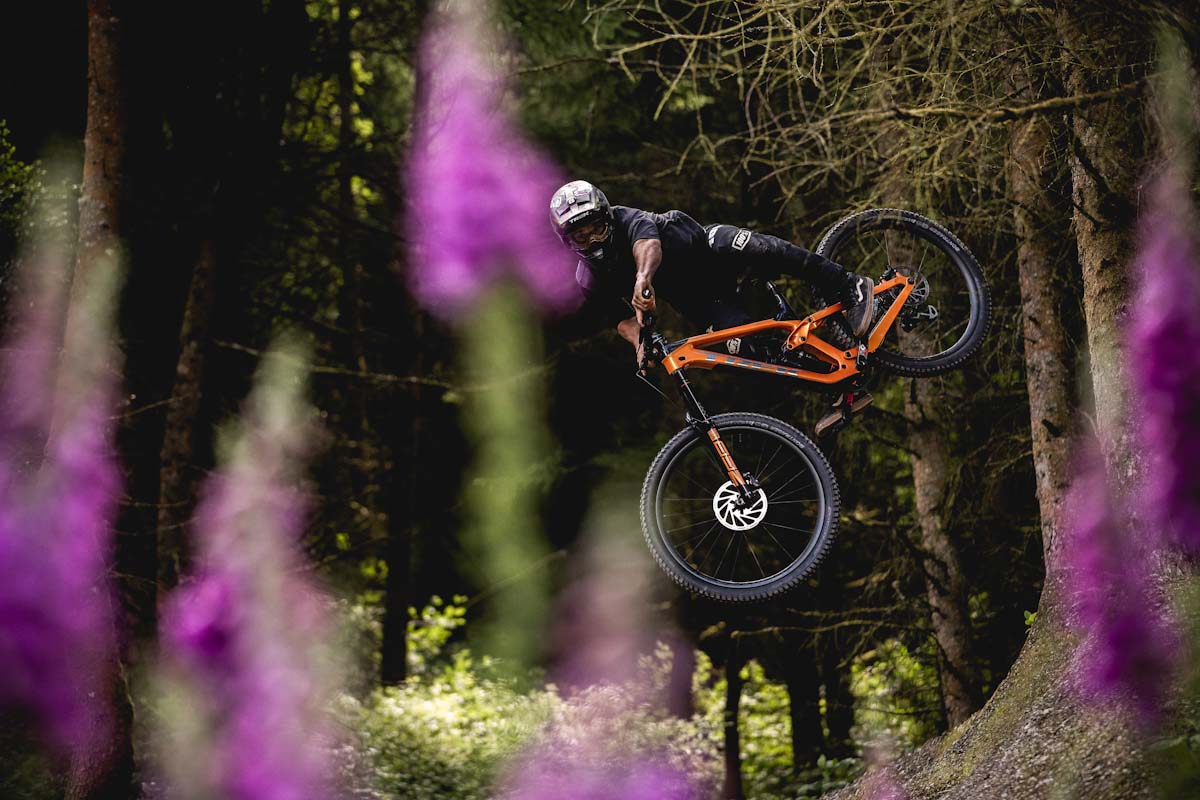
- Click to share on Facebook (Opens in new window)
- Click to email a link to a friend (Opens in new window)
With a burly-looking frame, slack steering, 160/170mm’s of travel and 29” wheels, the 2021 Slash is certainly a full-on enduro machine. The Slash was an early player in the long-travel niner department, and for 2021 it’s had quite the design overhaul.
The updated frame boasts new geometry, a revised linkage with more rear travel, and includes Trek’s take on down tube storage. Trek also fit this new frame with a custom shock: The new RockShox Super Deluxe Ultimate Thru-Shaft was designed for the Slash, and offers an adjustable open mode to help control rider inputs.

2021 Trek Slash frame and suspension:
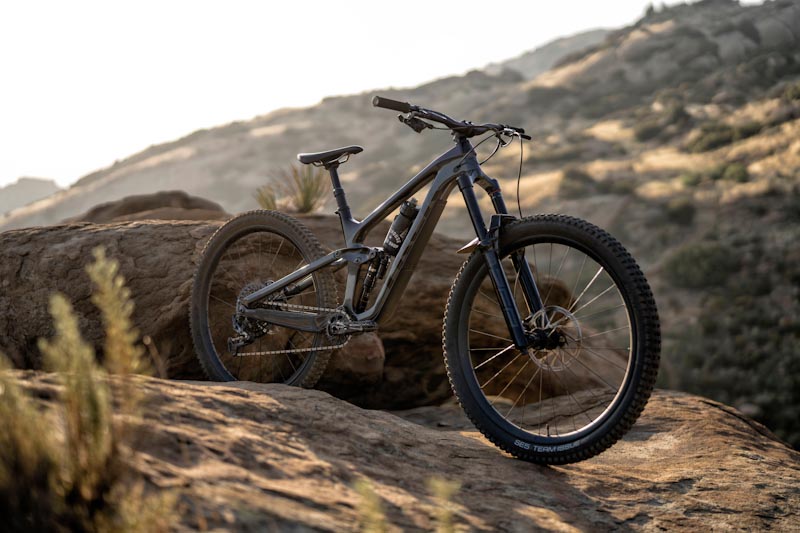
The 2021 Slash is offered in a bunch of carbon build options and one aluminum model. The carbon frame’s weight is 2450g/5.39lbs, which Trek claims is almost a pound lighter than ‘the competition’. Including the rear shock the carbon frame weighs 7lbs, and the aluminum frame/shock weighs 9.5lbs.
The Slash has grown in travel and seen its suspension tweaked for 2021. The bike now provides 10mm more squish in both ends, with 160mm of rear travel and 170mm forks (180mm forks are OK if you want ALL the travel). As for tuning, Trek adjusted the position of the Slash’s main pivot to achieve better pedaling efficiency, and they set it up with a specific new shock…
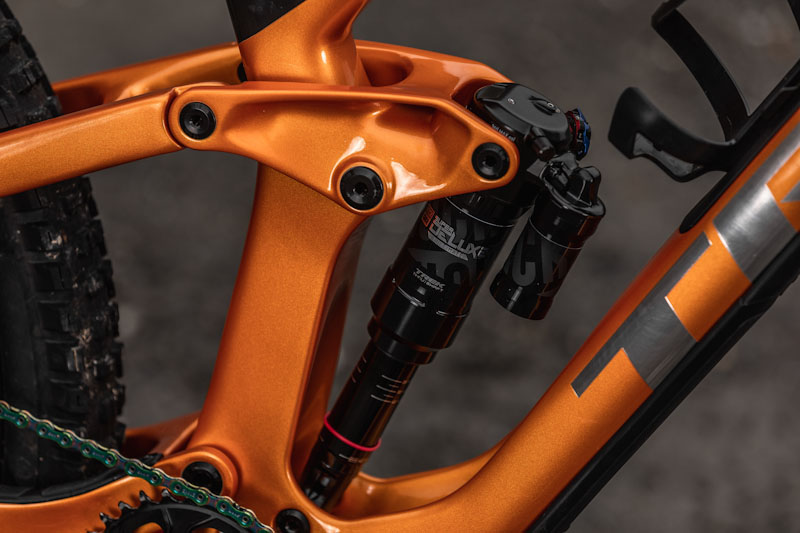
The Slash’s Super Deluxe Ultimate Thru-Shaft shock was co-developed by RockShox and Trek, who had similar ideas in mind about reducing friction and improving a shock’s ability to control rider inputs. The thru-shaft shock boasts an improved shim damper, an oversized thermal compensator and a tunable open mode with three settings.
The shock’s open mode settings are Plus, Minus, and Zero, and they adjust the low-speed compression. Zero serves as the middle setting, Plus adds a bit of compression for flowy or jump trails, and Minus offers the softest ride for tackling rough terrain. In stock setup the shock has no spacers installed, but both the positive and negative chambers can be tuned by adding them.
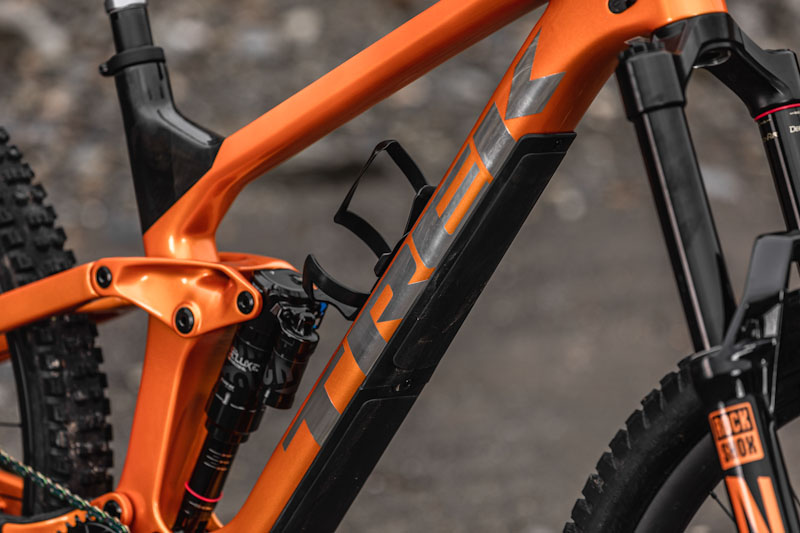
Should you wish to swap out the rear shock, the Slash is compatible with several other models of air shocks, and its linkage will work well with a coil shock too. You may have noticed Trek isn’t running a RE:aktiv shock on this year’s Slash: In short, they say they’re happy enough with the Super Deluxe Ultimate Thru-Shaft’s damping.
Knock Block 2.0!

Trek has also updated their Knock Block system, and the Slash comes with the Knock Block 2.0. The significant thing to note is that the new Slash frame will not come into contact with your fork crown, so you can remove the Knock Block 2.0 if desired. Trek kept it there because it can save you from ripping out cables/hoses in a crash, something racers would likely appreciate. Since the frame cannot be contacted, the Knock Block 2.0 offers a much wider steering range than the initial version, allowing for 72 degrees of swing instead of 58 degrees.

Trek has included their version of down tube storage on the new Slash, and they’ve managed to include it on their aluminum frames as well as the carbon models. Bontrager offers a suitable tool roll which has pockets for carrying a tube, tire levers, Co2 canisters and an inflator head. Though Trek shows them in some photos, the tool rolls are an aftermarket accessory and are not included with the bikes.
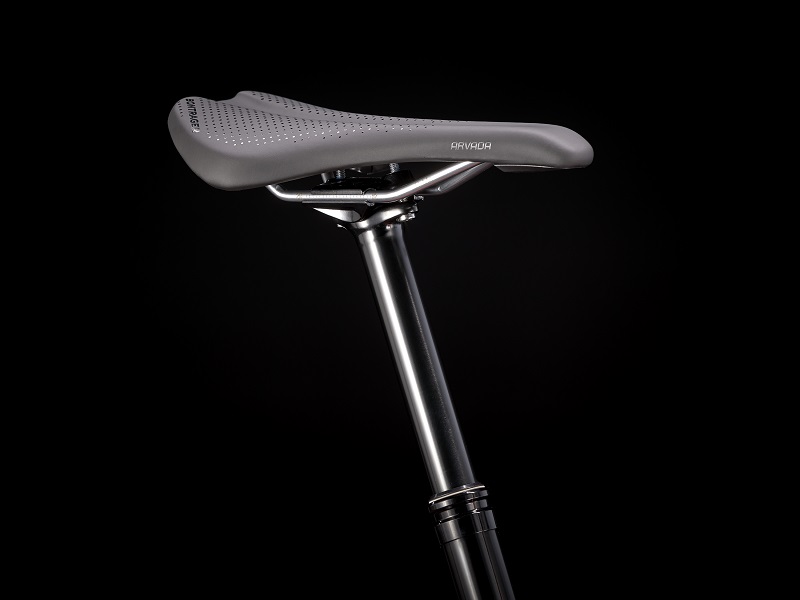
The Slash now runs a 34.9mm diameter dropper post ( Bontrager’s updated Line Elite 34.9 ). Trek jumped to the larger diameter as it makes for stronger posts with less side-to-side play and stiction. With an adjustment to the shock position, Trek’s 2021 frames offer 45mm more insertion depth for dropper posts. Mediums come with 150mm, Larges get 170mm, and XL’s get Bontrager’s new 200mm posts. While some brands are putting 170mm’s in medium frames (and it would be nice to see that on this bike) Trek did confirm a 170mm post will fit into a medium.
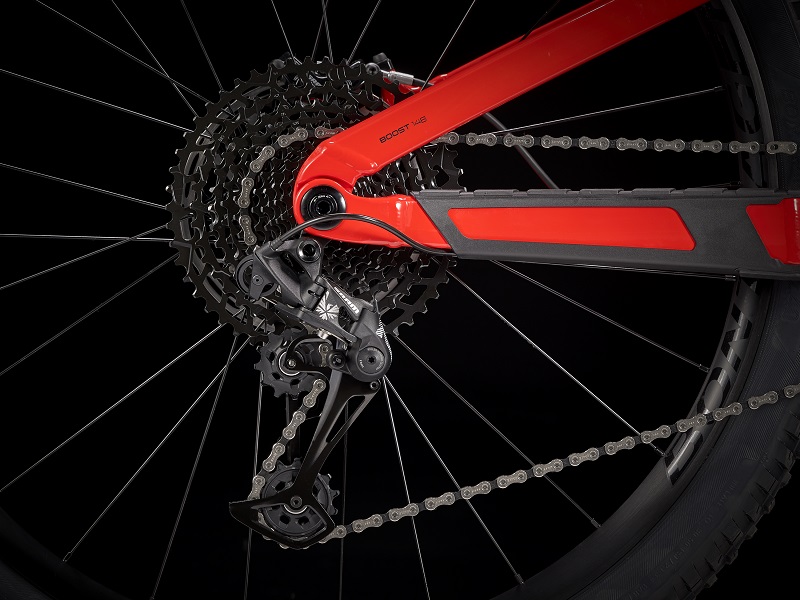
Other fitments include Boost 148mm rear spacing, and instead of last year’s press-fit BB, there’s a trusty BSA 73mm threaded BB shell with ISCG mounts. The frame runs a 55mm chainline, and will fit up to a 34t chainring. Trek has also adopted SRAM’s universal derailleur hanger for the new Slash. Tire clearance maxes out at 29×2.5”, and Trek does not intend for people to mullet this bike – It was built to be a niner!
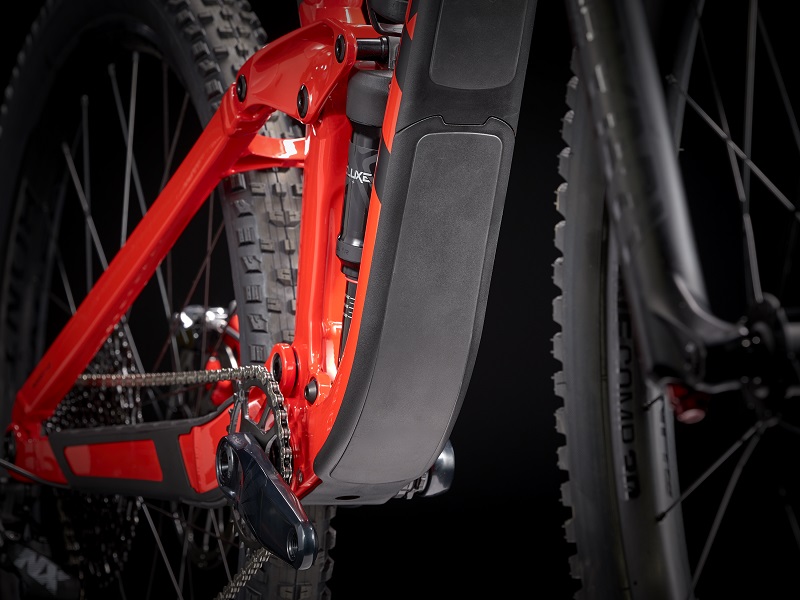
The Slash features Trek’s Control Freak internal cable routing, and between the port plugs and zip-tie attachments found inside the storage compartment, there’s no need for internally sleeved routing. Other finishing touches include a removable, full length, dual-density downtube protector for shuttling or fending off rock strikes, a chainstay protector, and enough room for a water bottle on all frame sizes.
2021 Slash geometry:
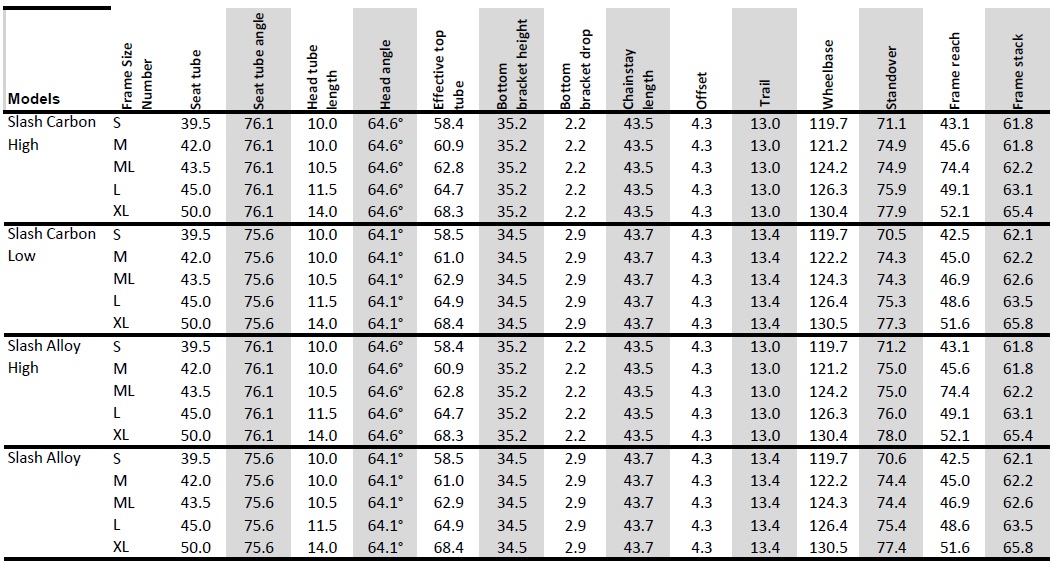
While the carbon and aluminum models were slightly different before, the geometry is now the same between all the 2021 models. The new Slash comes in S/M/ML/L/XL frame sizes. Versus last year’s Slash, the 2021’s head tubes were slackened by one degree, now sitting at 64.1 degrees. The seat masts are also 1-2 degrees steeper, with a new effective seat angle of 75.6 degrees.
Reach was also increased quite a bit with M/L frames now up to 450/469mm. While the front ends got longer, they were stretched out with the Slash’s stubby 35mm stems in mind, so the bikes won’t feel drastically longer than the 2020 versions. Trek has also gone from 51mm offset forks down to a very short 42mm offset.
All frame sizes run 437mm chainstays, which are 2mm’s longer than before to increase the wheelbase and better balance the longer front ends. BB height is now slightly lower, but only by about 1mm.
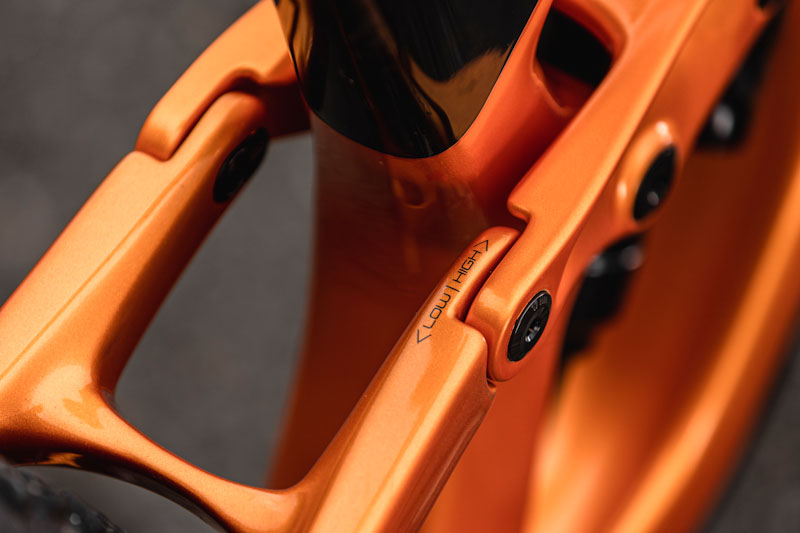
The Slash employs Trek’s Mino Link flip chip, offering Hi and LO positions. All numbers listed above are for the Lo setting – Flipping into Hi position steepens the head tube and seat mast by 0.5 degrees, shortens the chainstays by 2mm, lengthens the reach by 5-6mm, and lifts the BB up 7mm.
2021 Slash model lineup:
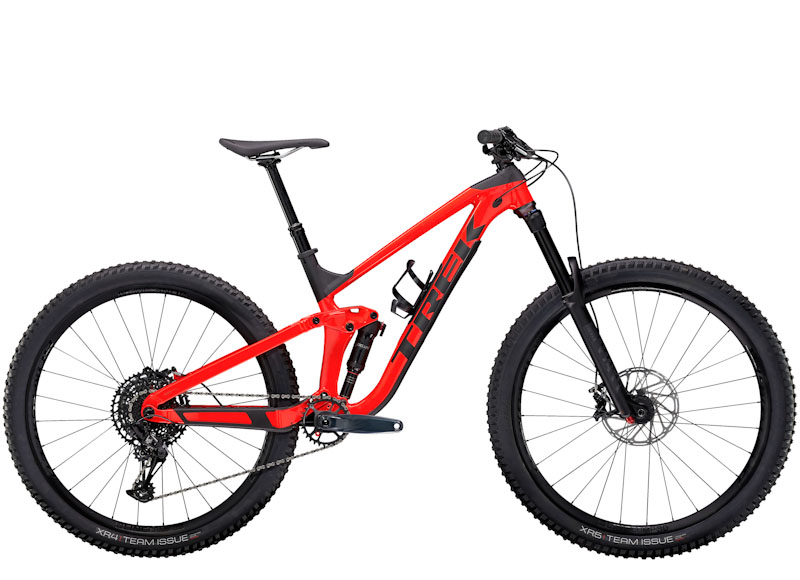
Slash 7 (Aluminum) – $3499.99
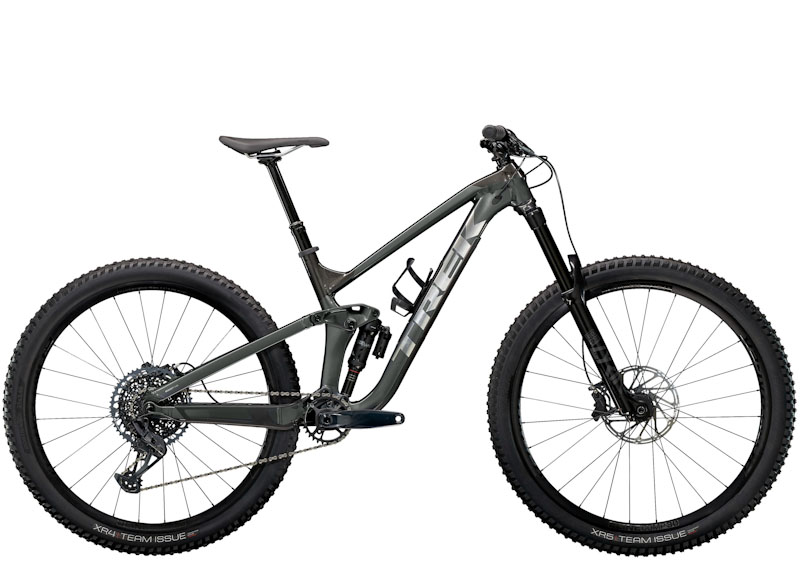
Slash 8 (Aluminum) – $3999.99
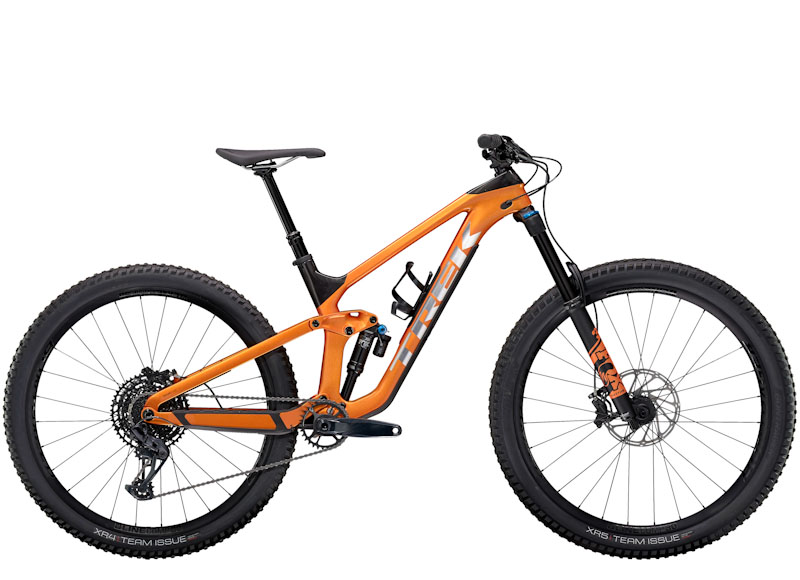
Slash 9.7 – $ 4799.99
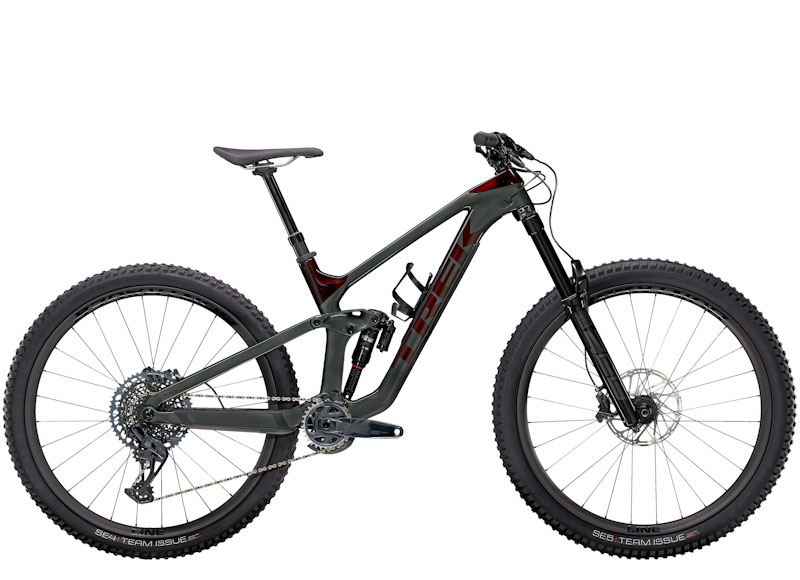
Slash 9.8 GX – $5999.99

Slash 9.8 XT – $5999.99

Slash 9.9 X01 – $7999.99

Slash carbon frameset – $3999.99

Slash AL frameset- $2199.99.
The carbon and aluminum framesets both come with a RockShox Super Deluxe Ultimate Thru-Shaft shock, the bottle cage/storage door, a headset with the Knock Block 2.0 headset cap, and a 35mm Bontrager Line Pro stem.
One final note: Trek’s Project One custom paint option is available for the 9.8 XT, 9.8 GX, 9.9 X01, and 9.9 XTR models. This upgrade will cost you an extra $500. The 2021 Slash is available now online and at Trek dealers (technically… like many bike brands right now, Trek says demand is greater than supply, so you may have to be patient!)
trekbikes.com

Steve Fisher is a staff contributor for Bikerumor. Steve has been writing about trail, enduro and downhill mountain biking (plus a few commuter bikes) for seven years. Prior to that, Steve wrote for Whistler Traveller Magazine and Mountain Life Magazine. Steve is based in Pemberton, British Columbia, an area that offers plenty of challenging world-class singletrack and makes for great photos!
This site uses Akismet to reduce spam. Learn how your comment data is processed .
Why is there not a “straight-shot” downtube. I thought it was a better design?
Follow Us On
Subscribe Now
Sign up to receive BikeRumor content direct to your inbox.
2021 Trek Slash
Test Location: Crested Butte, Colorado
Test Duration: 3 months
Size Tested: ML
Build Overview (Trek Slash 9.9 X01):
- Drivetrain: SRAM X01
- Brakes: SRAM Code RSC
- Fork: RockShox ZEB Ultimate
- Shock: RockShox Super Deluxe Ultimate Thru Shaft
- Wheelset: Bontrager Line Elite 30 Carbon
Wheel Size: 29”
Travel: 160 mm rear / 170 mm front
Blister’s Measured Weight (as built, w/o pedals): 32.25 lbs / 14.63 kg
MSRP: $3,499 – $8,999 ($7,999 as tested)
- Luke Koppa: 5’8”, 155 lbs / 173 cm, 70 kg; Ape Index +1; Inseam 31” / 79 cm
- Dylan Wood : 5’11”, 155 lbs / 180 cm, 70 kg; Ape Index +0.5; Inseam 32” / 81 cm
- Eric Freson : 5’10”, 165 lbs / 178 cm, 75 kg; Ape Index +1.5; Inseam 31″ / 79 cm

Just a couple of years ago, our reviewer Noah Bodman called the 2018 Trek Slash one of the best all-round Enduro bikes he’d ridden.
But in the world of mountain bikes, a couple of years feels more like a decade, given how quickly brands have been changing bike geometry, suspension, components, and almost everything else we use to ride. The Slash that Noah reviewed had been essentially unchanged since it was released in the 2017 model year, so many people have been eagerly waiting to see what would come next.
This September, Trek provided those people with an answer when they released the all-new, 2021 Slash.
Trek says their two main goals when redesigning the Slash were to (1) “enhance the Enduro race capability of the bike” and (2) “preserve the ultimate Trail rider experience.”
We’ve now had three reviewers on the Slash and have updated our initial review. First, we’ll dive into what Trek changed on the Slash to accomplish those two goals, how the new bike’s design compares to the rest of the crowded Enduro 29er category, and then discuss our on-trail impressions.
Aesthetically, the 2021 Slash looks very similar to the previous version, as well as many of Trek’s other bikes. It maintains most of the clean, fairly straight lines throughout the frame and still uses a similar version of Trek’s ABP, 4-bar suspension linkage. That said, there are a lot of noteworthy differences with the newest Slash that might not be obvious at first glance.
First and foremost, the 2021 Slash gives you 160 mm of rear travel and is designed around a 170 mm fork, while the previous version had 150 mm of rear travel and a 160mm-travel fork.
The Slash is still available in either a fully aluminum frame or fully carbon frame, with the two alloy builds designated with a single digit in their name (Slash 7, Slash 8) while the five carbon-frame builds are designated with decimal points (e.g., Slash 9.7, Slash 9.8, & Slash 9.9). However, while the old Slash’s geometry and some of its features differed between the alloy and carbon models, the 2021 Slash keeps pretty much all of the frame features and geometry the same, whether you opt for alloy or carbon. That’s great news for those who don’t feel like going the carbon route.
One of the most exciting new features is the frame’s integrated storage in the down tube, and the fact that it’s standard on both the carbon and alloy Slash. Similar to Specialized’s SWAT box and the down tube on the carbon Trek Fuel EX , the new Slash lets you open a little “hatch” on the down tube so you stash a tube, tool, burrito, or whatever other little items in the frame, and not on yourself.
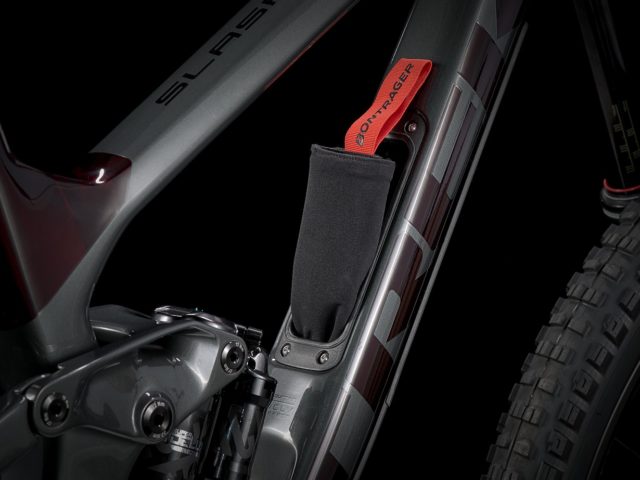
That little hatch on the down tube also serves as a mounting point for a water bottle cage, and Trek says all sizes of the 2021 Slash will fit a water bottle within the front triangle. Our size ML fits a 20-oz bottle quite easily. Cables are routed internally on both the alloy and carbon 2021 Slash, and they’ve been very quiet so far.
One of the more polarizing features of several Trek bikes is their “Knock Block” system. On the old Slash, this was essentially a keyed headset that prevented the front wheel from turning past roughly 58° to either side. On that bike, the down tube ran straight from the head tube to the bottom bracket, which Trek said let them get a more ideal strength-to-weight ratio from the frame. It also meant the fork could bash into the down tube without the Knock Block system during a crash, an ultra-tight turn, or if you finally decided it was time to learn barspins.
The 2021 Slash features what Trek is calling “Knock Block 2.0.” In its stock configuration, it still prevents the wheel from turning all the way around, but you can now turn the bars 72° to either side, as opposed to 58° on the old version. The 2021 Slash’s new, slightly curvier down tube also means it has enough clearance for the fork’s crown, and given that, Trek made Knock Block 2.0 removable, and it will now work with “standard” stems that aren’t Knock Block specific. Given that there’s no longer a physical conflict with a straight down tube, Trek says the primary purpose of Knock Block 2.0 on the 2021 Slash is to help prevent wear on the top tube and cables from pulling out.
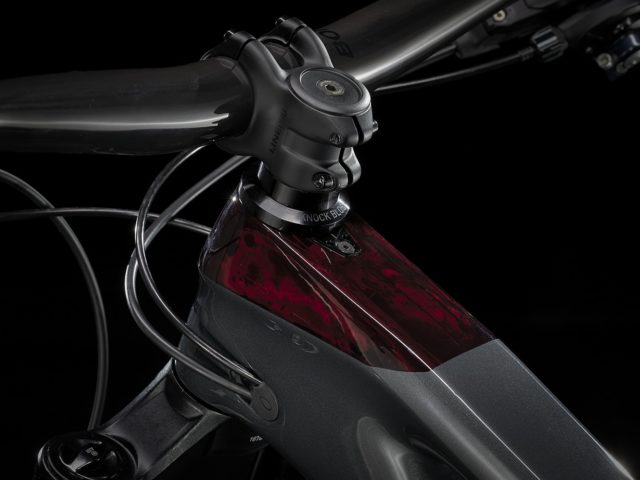
While it ditches the “Straight Shot” down tube of the last version, the 2021 Slash is still touted as being light and strong, with Trek claiming a stated weight of 2450 grams for the carbon frameset (we’re working on confirming which size that weight is for). Our size ML Slash 9.9 X01 weighed in at 32.25 lbs / 14.63 kg without pedals, which isn’t exceptionally lightweight for a high-end, 160/170 mm bike, but also not particularly out of the ordinary for a long-travel 29er.
One cool feature on the 2021 Slash that we don’t see on too many other bikes is its massive down tube protector. Running from the bottom bracket to just a few inches shy of the head tube, the dual-density pad should keep the down tube looking fresh for longer, particularly for people who often shuttle their bikes. And as would be expected, the new Slash also features some protection around the chainstay.
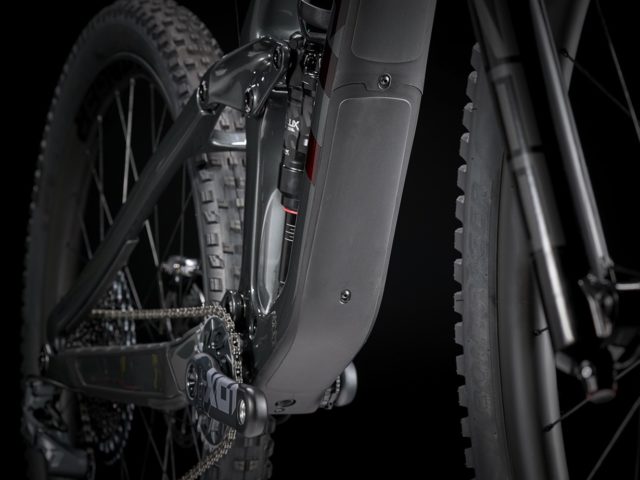
Speaking of the bottom bracket, the 2021 Slash comes with a BSA 73 one that’s got threads in it, rather than the press-fit BB on the old version. This should equate to less creaking and easier service. The new Slash also gets a larger, 34.9mm-diameter seat tube to accommodate the increasingly popular droppers of that diameter (including the new 34.9 mm Bontrager Line Elite spec’d on the higher-end Slash builds).
The Slash uses 110×15 mm hub spacing up front and 148x12mm out back, which is pretty standard, and Trek says the max rear tire size is 29”x2.5”. Other misc. specs include a rear brake mount that fits 180 mm rotors directly and fit up to 220 mm rotors, the ability to run chainring sizes from 28-tooth to 34-tooth, and stated dropper post insertion depths ranging from 205 mm on a size Small to 310 mm on a size Large.
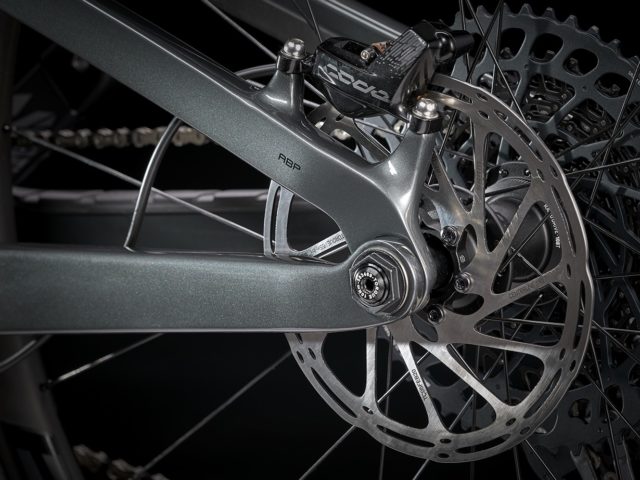
Suspension Design & New RockShox Super Deluxe Ultimate Thru Shaft
The 2021 Slash’s overall suspension linkage is still pretty similar to the previous Slash, using a version of Trek’s 4-bar “ABP” linkage. They’ve been using this general design for years, and a few of our reviewers have particularly been fans of how active the ABP linkage tends to stay under hard braking.
Like the old version, most 2021 Slash builds come with a special version of a RockShox rear shock that features the exclusive-to-Trek “Thru Shaft” design, but again, there are some notable differences.
First, the 2021 Slash’s shocks no longer feature Trek’s special “RE:aktiv” tune, which essentially relied on speed-sensitive damping and was meant to help the shock stay firm during low-speed forces (e.g., pedaling) while opening up during bigger impacts. Trek says they made this change because they felt a shock without the RE:aktiv tune was better suited to the demands of modern, high-speed Enduro races, which are becoming more and more like multi-stage DH races.
Second, several of the 2021 Slash bikes (carbon frameset, 8 build, 9.8 builds, & 9.9 builds) come with a special version of the RockShox Super Deluxe Ultimate , rather than the special RockShox Deluxe RT3 on the old Slash.

So, what’s so “special” about these shocks? Well, the Thru Shaft design itself is exclusive to shocks on Trek bikes, and was something that Noah really liked about the old Slash’s shock. After swapping between the two, he found the Thru Shaft shock made the bike feel much smoother and more sensitive over small chatter compared to when he swapped to a regular Super Deluxe shock. (Noah already went into a lot of detail regarding Thru Shaft in his review of the old Slash , so I’d check that out if you want to get more into the weeds about how it actually works.)
While Thru Shaft itself isn’t new, the Super Deluxe Ultimate on the 2021 Slash is. Its most notable new, exclusive feature is a 3-position switch (the bright-blue knob on the shock) that’s meant to specifically change how the suspension is affected by rider input (i.e., slower-speed forces created by the rider pushing down on the bike), without affecting damping during higher-speed impacts that come up from the trail. In simpler terms, it lets riders quickly switch between three preset low-speed-compression settings.
The “0” setting is supposed to be the baseline, general-trail-riding setting that you’d use in most cases. The “–” setting decreases the amount of low-speed compression, which Trek says makes more sense on steeper and rougher trails where the rider’s weight is biased more toward the front of the bike, and not the rear. Then the “+” setting adds more low-speed compression, meant for smoother, flow-style trails where you want a more supportive platform for pushing into berms and off jumps.
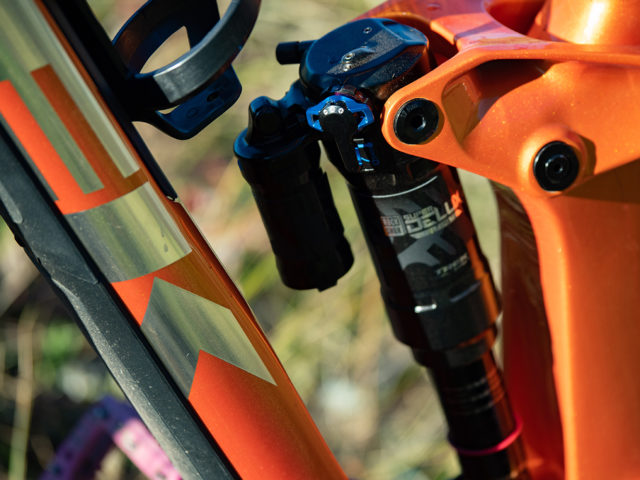
This new 3-position switch is not a “climb” switch or a lockout lever — the Super Deluxe Ultimate Thru Shaft has a separate, 2-position lever that you can use to fully lock out or fully open the shock. The lockout lever is situated directly over the 3-position switch on the shock.
Aside from that new 3-position LSC adjustment, the Super Deluxe Ultimate Thru Shaft on the 2021 Slash also features a larger, tunable negative air spring, which is meant to make the shock more progressive and supportive near the end of its travel, without losing the small-bump and mid-stroke sensitivity supposedly offered by the Thru Shaft design. You can also add volume spacers to both the negative and positive air springs to fine-tune the shock, though the Super Deluxe Ultimate Thru Shaft comes stock without any spacers inside.
RockShox also tweaked the positioning of the dials and switches on the Super Deluxe Ultimate Thru Shaft, putting them on the left side for easier access and they also added numbers to the single rebound-adjustment dial to make it easier to know what setting you’re on.
Now, I just used a lot of words to talk specifically about the exclusive Super Deluxe Ultimate Thru Shaft shock that comes on most of the 2021 Slash builds. However, many people will be happy to know that you can still fit several other shocks on the Slash, including the 2021 Fox Float X2 , 2021 Fox DHX2, Fox DPX2, RockShox Super Deluxe Coil, and most inline shocks without piggyback reservoirs. Trek says the regular, non-Thru-Shaft Super Deluxe won’t fit due to where its lockout lever is placed. They say that the leverage ratio of the new bike is progressive enough that most coil shocks are compatible, though I’d recommend checking with them just to be sure you won’t have any clearance issues with the coil shock you’re considering.
Trek is talking a pretty big game about this new Thru Shaft shock, so we’re very curious about (1) how well it’ll live up to Trek’s various claims, (2) how useful the new 3-position LSC switch actually is, and (3) how it compares to other downhill-oriented air shocks that don’t feature Thru Shaft, but that do feature more finely adjustable compression and rebound settings.
As of publishing this First Look, the 2021 Slash is available as an alloy frameset ($2,199), carbon frameset ($3,999), or in 7 full builds ranging from the $3,499 Slash 7 to the $8,499 Slash 9.9 XTR.
For all of the carbon builds, you can also customize the color / paint of the frame through Trek’s Project One program, which adds $500 to the cost.
At $3,999, the Slash 8 in particular seems like a pretty solid deal: you get the special Thru Shaft shock, RockShox Lyrik RC fork, full SRAM GX drivetrain, and SRAM Code R brakes.
We’re testing the high-end Slash 9.9 X01 build, which leaves little to be desired for the price of $7,999.
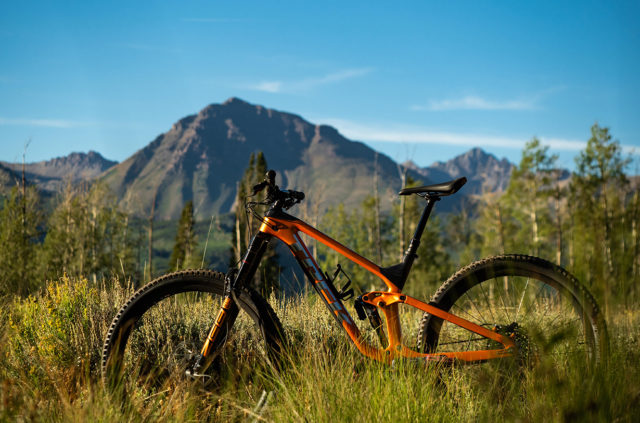
Here’s the quick rundown on some of the Slash 9.9 X01 build highlights:
- Rear Shock: RockShox Super Deluxe Ultimate Thru Shaft
- Wheels: Bontrager Line Elite 30 carbon
- Front Tire: Bontrager SE5 2.6”
- Rear Tire: Bontrager SE4 2.4”
- Dropper Post: Bontrager Line Elite 34.9
- Handlebar: Bontrager Line Pro carbon
Geometry & Fit
Like every other new bike in recent memory, the 2021 Slash is longer, has a slacker head tube angle, and a steeper seat tube angle than its predecessor. With that said, the changes are not quite as drastic as you might expect, given some of the radical bikes released in the past year. And that seems in line with Trek’s goals of improving racing capabilities while maintaining more general trail-riding performance.
[The geometry of the new Slash, as well as the new Pivot Switchblade and now-fairly-old Rocky Mountain Instinct BC , actually kickstarted an interesting conversation around Blister pertaining to the current status and future of mtb geometry, which you can check out on our Bikes & Big Ideas podcast .]
The old Slash wasn’t the longest option in its class when it was first released, the 2021 Slash also isn’t truly pushing the limits in terms of length, and that’s something several of us are actually quite excited about.
Depending on the size of the frame, the new Slash’s reach is 15–41 mm longer than the last iteration, with a size M coming in at 450 mm, an ML coming in at 469 mm, and a size L coming in at 486 mm. Compared to, say, Commencal’s new Meta TR and Meta AM, the Slash’s reach numbers sit slightly on the more conservative side, though they’re pretty much in line with bikes like the newest Transition Sentinel and Norco Sight.
Compared to the last version, the 2021 Slash’s head angle gets slacker by a degree, sitting at 64.1° in the Low setting and 64.6° in the High setting of its “Mino Link” flip chip (the bike comes stock in the Low setting). While we’re seeing more bikes in this class with sub-64° head angles, the new Slash’s head angle seems relatively standard for Enduro bikes these days.
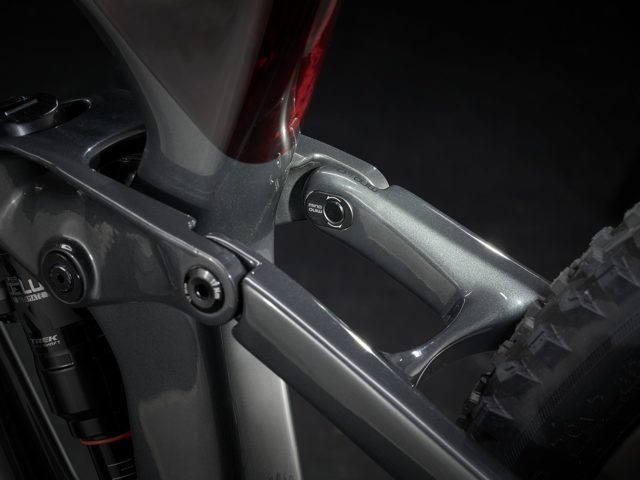
Combined with chainstays that didn’t change much (2 mm longer at 437 mm in the Low setting), all of that adds up to a longer, but not extremely long wheelbase: 1222 mm for a size M, 1243 mm for a size ML, and 1264 mm for a size L.
Just looking at the old Slash and comparing it to newer bikes, the most obvious difference in its geometry is probably its seat tube angle. With a 73.6° effective seat tube angle and 64.3° actual seat tube angle, the old Slash looks very different than the numerous bikes of today with seat tube angles approaching (or even reaching) 80°.
The 2021 Slash’s seat tube still has a significant “kink” in it, keeping its actual seat tube angle quite slack at 66.6°, but its effective angle has gotten almost 2° steeper, with Trek claiming 75.6° with the saddle height at 750 mm. That’s still notably slacker than a lot of bikes these days, and given the very slack actual angle, this may still present some issues for people who need to run very long droppers. But we’re curious to see just how noticeable that seat tube angle actually is.
All in all, the new Slash features pretty much all the geometry changes you’d make if you wanted to make a bike more stable at speed and in steep terrain, and more comfortable on steep climbs. Other brands have taken those changes even further and others have been more conservative, with the new Slash sitting roughly around the middle of the pack for a bike in this class.
As for sizing / fit, the 2021 Slash adds an “ML” size to the lineup, which will be great news to people like me and Noah, who were split between the fairly large sizing gap between the M and L sizes on the old Slash. With reach numbers ranging from 425 mm on a size S to 516 mm for a size XL, the 2021 Slash should work for a wide range of riders. Like most bikes (but increasingly, not all ), the 2021 Slash’s chainstay length is the same across all sizes, which may be something to consider for riders at the upper and lower end of the sizing spectrum, but having equal-size chainstays across all sizes is still pretty much the norm these days.
For reference, here’s the full geo chart for the 2021 Slash:
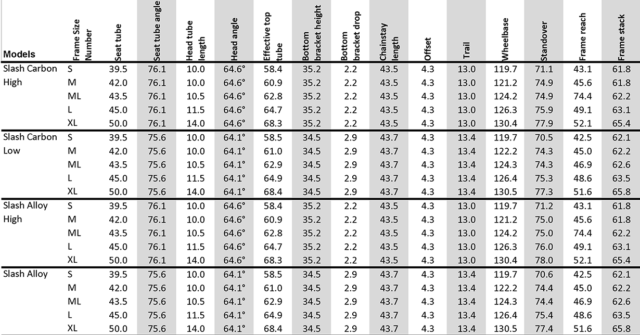
FULL REVIEW
We received and built up the Slash 9.9 X01 on September 1st, and Luke Koppa got a few days on it before passing it off to Dylan Wood and Eric Freson, who now add their thoughts after riding it for a few months.
Geometry and Fit
Luke Koppa (5’8”, 155 lbs / 173 cm, 70 kg): At my height, I slot right around the middle of Trek’s recommended range for the size ML we’ve been testing. Unsurprisingly, the bike immediately felt comfortable to me.
I didn’t have any complaints about the Slash’s seat tube angle being too slack, though I admittedly tend to be a bit less sensitive to that than some other folks. The main thing I noticed on the uphill in terms of geometry was that the 2021 Slash does feel like a pretty long and slack bike in tight and / or steep sections. Compared to the shorter and steeper size Medium Specialized Enduro 27.5 and size Large Rocky Mountain Instinct BC I’ve been riding, the size ML Slash’s front wheel felt a bit more difficult to keep planted in steep spots and it required more physical input on my end to maneuver the bike over / around obstacles. This didn’t come as any surprise to me, and at least so far, seemed like nothing out of the ordinary for a bike with the Slash’s geometry.

And the good news is that, on the descent, I basically had no complaints about the geo of the Slash. It just felt nice — plenty slack in steep terrain, and once I got even just a bit of speed going, it didn’t feel excessively long or cumbersome.
Dylan Wood (5’11”, 155 lbs / 180 cm, 70 kg): The size ML Slash’s fit and geometry did not take very long to get used to, despite the fact that Trek actually recommends a size L for someone my height. At 5’11” / 180 cm, I am in the middle of the sizing range for a size L Slash, and I’m technically just outside of the recommended height range for the size ML we’ve been riding.
That said, the ML Slash’s geometry numbers are actually quite similar to the size Large Santa Cruz Megatower I’ve been spending a lot of time on, which is probably why the ML Slash has felt so familiar to me. Given that Trek technically recommends a size Large for me, it’s worth keeping in mind that the ML size I’m talking about might feel a bit shorter and snappier than a size L that many people my height may end up riding.
I agree with Luke that the Slash is indeed a pretty long bike and that length is noticeable on tight and / or steep climbs. Due to its slack front end, long wheelbase, and likely the not-super-steep seat tube angle, the Slash’s front wheel tends to wander a bit on technical climbs and is moderately difficult to keep weighted. This happens on most bikes this slack and long, though I think it might be slightly less of an issue with a steeper seat tube angle.

Regarding that seat tube angle, the pedals feel a bit further forward on the Slash than I’d prefer. I do run a fairly high seat height (78 cm), which results in the seat being further back due to the “kink” in the seat tube (more so than someone like Luke with shorter legs). To help combat this, I slid the Slash’s seat all the way forward on the rails and it made a significant improvement to my pedaling position. Personally, I wish Trek would’ve made the seat tube angle steeper on the Slash, though I also don’t think it is reason enough to steer anyone away from buying a Slash. Just something to keep in mind, particularly if you climb up a lot of very steep trails and / or have very long legs (and will therefore be running a longer dropper post).
Eric Freson (5’10”, 165 lbs; Ape Index +1.5; Inseam 31″): Not a ton of new to add here!
I also got along well with the fit of the ML Slash. Like Dylan, I found myself moving the seat all the way forward on the seat rails to effectively steepen the seat tube angle a touch. But I do this on most bikes I ride, since I often find myself sizing up on frames and am typically on the smaller side for their intended sizing. Moving the seat forward gives me a slightly shorter cockpit when seated.
When it comes to the geometry, the biggest standout for me with the Slash is actually the “ML” sizing option. As someone who is often right on the line between Medium and Large frame sizes, and who wants to always feel like I have the best tool for the job, the Goldilocks “just right” option of a ML frame has a ton of appeal for me. I just like the warm fuzzy feeling I get when I think about how Trek made a size just for “me” (and every other 5’9 to 5’11 person who wants to feel cool by going up a frame size but worries about seat / body / reach positioning). The jumps between sizes on the Slash aren’t really smaller than average, but a size that’s targeted between a lot of bikes’ Medium and Large offerings is welcome for me.
To echo what the others have said, the cockpit of the Slash does feel fairly long and stretched when seated. When climbing, the front wheel would sometimes feel light and prone to wandering. In particular, climbing tight switchbacks required an extra degree of focus on body positioning to stay balanced and keep the front wheel planted.
Luke Koppa : On the uphill, the 2021 Slash’s suspension feels to me like it falls into the “great traction, not super efficient” category. There’s a noticeable amount of pedal bob, particularly when out of the saddle — not as wallow-y as the 2019 Specialized Enduro 27.5 or Stumpjumper, but not as firm as the Revel Rail. I found myself preferring to lock out the shock for the smoother sections of climbs, but when I left it open, I did appreciate the noteworthy lack of wheel slip on very loose, chunky sections. For reference, I’m 5’8”, 155 lbs / 173 cm, 70 kg and had the rear shock’s sag set around 27% and the fork’s around 16%.
I kept the shock’s 3-position LSC adjustment in the middle “0” setting during my first few rides, but I ended up using the shock’s “+” setting for most singletrack climbs since it seemed to strike a more preferable balance of pedaling support and traction. For super loose climbs where I wanted all the traction I could get, I’d leave the shock open and in the “0” setting. And for smooth road climbs, I’d just fully lock it out. Overall, I think the Slash climbs just fine for a long-travel bike, but it’s definitely not as snappy on the pedals compared to some of the best options in this travel class (e.g., Revel Rail and Ibis Ripmo).
Dylan Wood : I agree with Luke here. The Slash is an average climber for its class and should satisfy most riders who have been happy pedaling ~160mm-travel bikes in the past (i.e., those who prioritize going fast on the descent, not the uphill).
I am similarly content with the amount of traction that the Slash’s rear end provides on the way up — it feels active while pedaling over rough sections of trail. I occasionally used the lockout switch to firm up the shock, mostly on smooth roads and on some smoother singletrack. Like Luke, I also appreciated the option to switch the rear shock into the “+” LSC setting, which added a little more pedaling support without feeling like it was fully locked out and / or significantly reducing rear-wheel traction. Overall, the Slash climbed just about as I’d hoped it would, feeling basically on par with the Santa Cruz Megatower in terms of overall pedaling performance.
Eric Freson : Another vote for “average climber for its class and intended use.” I was pleased with the pedaling platform and traction available when going uphill on the Slash. The climbing position, (taking into account the somewhat-slack seat tube angle, very wide bars, and large reach), was for me the largest culprit in its average-feeling climbing prowess. The Slash just doesn’t really put me in a position over the bike to encourage me to attack the trail on the way up.
An aspect of the bike’s climbing ability that really stood out to me was just how firm the lockout feature was on the RockShox Super Deluxe Ultimate Thru Shaft shock. As someone who habitually reaches for this lever whenever I’m given the option, I frequently found it to be firmer than I was looking for on rougher, more technical climbs, and consequently could have a negative impact on available traction. It’s impressively firm, but this also meant that I found myself using it less than I might on a different bike. The pedaling efficiency of the Slash (and the ability to easily adjust the LSC settings) made this no big deal, but it was something that felt different than the norm for this class of bike.
Luke Koppa : As I think should be the case with a bike like this, I immediately started loving the Slash more and more as soon as I got to head downhill. Compared to the size Large Rocky Mountain Instinct BC and size Medium 2019 Specialized Enduro 27.5, the size ML Slash felt notably less prone to getting knocked off-line. And despite it being a totally new bike to me, I very quickly felt comfortable carrying as much, or very likely more speed on the Slash than I would have on those other bikes. The fact that the Slash is more stable is no shocker (given its longer and slacker geo), but I do think the seemingly non-existent adjustment period I had is noteworthy.

The standout characteristic of the Slash during my time on it was how calm and well-damped the entire bike felt while riding fast through rocky and rooty sections. Both the ZEB up front and Super Deluxe Thru Shaft out back did a great job of muting out small and medium-sized chatter. And I think some of that damped feel might also come from the Slash 9.9 X01’s carbon Bontrager rims and bar, but I can’t say for sure. The smooth, almost “deadened” ride of the Slash 9.9 X01 reminded me of a 2019 Specialized Enduro 29 I rode with an Ohlins coil shock, Roval Traverse carbon rims, CushCore inserts, and DH-casing tires.
Dylan Wood : Once I point the Slash downhill, the miles I climbed to the top all start to become worth it. Despite being a long-travel bike that was at least partially designed with racing in mind, the Slash has been a blast to ride on many different types of trails and I believe a wide variety of riders will get along with its handling and ride feel.
The Slash felt very composed while going fast through rocky sections, and it seemed like it wanted to go exactly where I was looking. The big wheels and smooth suspension let me carry plenty of speed, while its generally stable and composed ride allowed me to confidently keep off the brakes without feeling like I was on the edge of control. I agree with Luke in that the Slash felt extremely intuitive from the very first ride — it felt as natural as if I’d been on it for a month.
To me, the standout quality of the Slash was the reliable traction it provided across pretty much all scenarios. Trek’s ABP rear suspension layout, the tune on the rear shock, the RockShox ZEB up front, and the Bontrager tires all combined to ensure that the wheels stayed pressed to the ground and headed in the right direction when I needed them to. Particularly in rough, steep sections and when slowing down to make a corner, the Slash felt stiff enough to be precise, but the suspension did a great job of staying active and smooth. Like Luke, I also found that the Slash did a great job of staying on line in off-camber sections, with minimal effort required to keep its wheels from getting knocked off track.
In addition to rough and steep terrain, I’ve also spent a significant amount of time on the Slash riding bike-park style trails with jumps and berms. While I am no Kade Edwards, I had no problem getting the size ML Slash into the air and throwing it sideways. The Slash was a ton of fun on machine-built jump and flow trails (particularly when using its shock’s “+” setting), and it would make a ton of sense for those who often find themselves riding lift-accessed bike park trails.
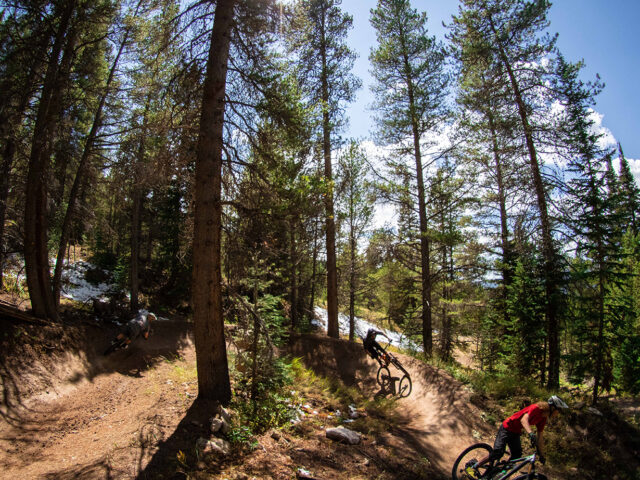
One of my few complaints with the Slash is that it occasionally felt a little overwhelmed on fast g-outs and especially hard hits. I would describe the Slash as feeling pretty forgiving overall, whereas a bike like the Santa Cruz Megatower (which strikes us as more racing-oriented) felt more supportive. That said, I would be curious to try adding a volume spacer to the Slash’s rear shock to see if it could make it feel more supportive during big hits, without seriously compromising its supple feel over smaller trail chatter. In its stock form, I think the Slash 9.9 X01’s suspension setup will feel really nice to those who prioritize small-bump sensitivity, while those who instead prioritize support for big hits may want to experiment with the settings a bit.
I think the Slash is a great option for riders who will be riding a variety of terrain as well as the occasional Enduro or casual Downhill race. But for those who are purely concerned with riding as fast and hard as possible on their long-travel Trail / Enduro bike, I think there are some better (and probably less versatile) options out there. And of course, the Slash is a 160mm-travel bike, so if you ride trails that are mostly smooth and / or not very consistently steep, a shorter-travel bike would make more sense.
Eric Freson : I’d piggyback on most of what Dylan said, and his summary of the Slash captures my feelings well. A couple things that stand out to me specifically:
The Slash is a stiff bike, and feels like a precise descender. It’s also a bike that wants you to get it up to speed quickly and keep it there, rather than gaining and shedding momentum frequently (i.e., steep and sustained descents, rather than undulating ones). The bike feels very, very composed at speed, and given that, I found myself letting off the brakes and carrying speed through a lot of rough sections of trail where I might otherwise be inclined to slow down and pick my way through. Conversely, getting it up to speed, or back up to speed, was more work on the Slash than some other bikes in this category that I’ve ridden (e.g., Revel Rail 27.5 ).
It did take me a bit to dial in the sag of the Slash’s rear shock and find exactly where I wanted to leave it. The smooth and controlled damping from the RockShox Super Deluxe Ultimate Thru Shaft shock made it a bit harder to pick out when settings were really off, and so it simply took a bit more time and a bit more attention to refine my ideal sag. I wouldn’t call this a problem — bracketing suspension settings just took a bit more time than average since the range in which it felt “good” was broad. The upside is that it was easy to find a combination of settings that felt at least good , it was just a bit tougher to find settings that felt truly, 100% ideal . But with my preferred settings dialed in, I have been very impressed by both the ZEB Ultimate fork and the RockShox Super Deluxe Ultimate Thru Shaft shock.
In contrast to my feelings about the long cockpit of the Slash while climbing, I really enjoyed the ample length when taking the Slash to the air. It helped me feel like I had a ton of room to adjust my body positioning once headed skyward, and also helped to slow down the bike’s response to those same body adjustments. As someone who isn’t most at home taking off features with big lips or significant “kick,” this large margin for error and forgiving nature was noticed and appreciated.
Finally, I can relate to Dylan’s experience with the Slash and its tendency to prioritize sensitivity and traction over outright support and bottom-out resistance. The Slash is a bike that feels smooth, and it’s going to help most folks feel comfortable and in control in most normal trail situations. I think for the vast majority of riders, the balance between sensitivity and support the Slash offers is going to be very appealing. The tune of the shock helps to inspire speed, stability, and confidence over normal trail noise and obstacles in a way that is highly impressive. But if you are a “pro” level rider or particularly aggressive, you may find yourself wishing for a bit more support from the Slash and might be better off on something else, such as the Santa Cruz Megatower , Guerrilla Gravity Gnarvana , or Privateer 161 (which we’ll be reviewing soon).
RockShox Super Deluxe Ultimate Thru-Shaft Rear Shock
Luke Koppa : I spent most of my time on the Slash with its shock set on the baseline “0” LSC setting and occasionally the firmer “+” setting.
The 0 setting worked pretty well for most trails and my riding style, just as it should, given that it’s the baseline setting. The Slash is a bike that is the most fun when the trail is at least somewhat steep, and the 0 setting felt great on nearly all the trails I rode that fit that criteria.
That said, on flowier, mellower trails I’d find myself wishing for a slightly firmer, more supportive platform for getting in quick pedal strokes and pumping, and the + setting pretty much gave me that. It wasn’t some night-and-day difference, but it was definitely noticeable. I felt like the rear end wasn’t wallowing / sinking quite as much, and given that the switch is so easy to flip, I’d change it to the + setting any time I knew the trail ahead was going to be fairly smooth and not wildly steep.
Overall, I personally really like the concept and execution of the 3-position LSC switch. I’m not someone who’s constantly tinkering with my suspension and opting to shell out a bunch of extra dough so I have one or two more dials to play with. Instead, I just want to quickly find the setting(s) that work well for me on most of my rides. With the Slash’s shock, I got along well with both the 0 and + settings (I didn’t ride any trails that I felt warranted the “–” setting), and it was extremely easy to switch between them. So for me, the Slash’s shock covers just about any adjustment I could want, though I could see certain people preferring a more traditional high-end shock with more fine-tuning options.
Dylan Wood : The shock on this bike is one of the highlights of the component spec for me, and makes it stand out from other long-travel 29ers. I have been running Trek’s recommended 175 psi (generated by their suspension calculator ), and it results in 30% sag.
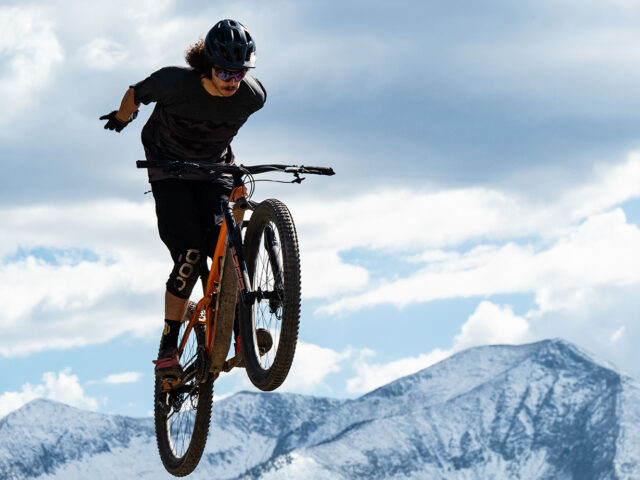
I really enjoyed the 3-position low-speed-compression settings on the shock. When I knew what was in store on a given trail, it was very easy for me to change the settings to match the terrain. Put it in “+” for a flowy trail, “–” for steep and rough, and “0” for a little of both. This swap is so easy to make, I would do it several times on rides where the terrain changes between transitions (e.g., Hartman Rocks in Gunnison). These adjustments make for an immediate change in the feel of the bike, especially the “+” setting. When I didn’t know what was coming up, putting it right in that middle “0” setting was my go-to, and it is a great set-it-and-forget-it setting for those who would prefer not to tinker with their bike.
Of course, as Luke alluded to, certain riders may want more adjustment options. From my perspective, I think about 90% of riders could get along great with the Trek’s 3-position LSC switch for all of their riding. But particularly for racers or just those who are extremely sensitive to their suspension settings, this relative lack of adjustability could be a drawback on the Slash.
As for the other features of the shock, the numbered rebound dial is a no-brainer that I think every shock and fork should have. It gives you 10 settings to choose from, which could mean you don’t have as many settings as some other high-end shocks, but we always felt like we were able to arrive at a rebound setting that felt good to us.
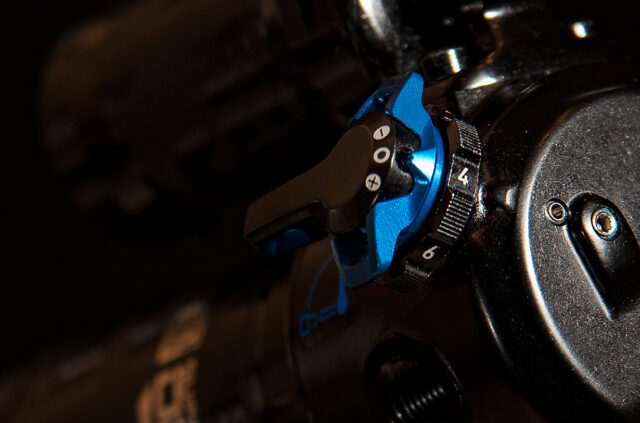
Overall, I think the Slash’s rear shock feels great as a whole and I have trouble finding anything I would personally change about it.
Eric Freson : I agree with everything said above. As someone who normally likes to try to set up his suspension to perform best in the aggregate, rather than fine-tune on a trail-by-trail basis, I appreciate how easy it is to make noticeable changes to the behavior of the rear suspension without needing to remember how many clicks of LSC and LSR I backed off two rides ago. It’s practical and functional — which encourages you to actually use it — and that is a hallmark of a good design in my book.
Bottom Line
Luke Koppa & Dylan Wood : Trek seems to have done a good job of accomplishing their two main goals with the Slash. It’s a long-travel bike that feels very stable, smooth, and forgiving on rough descents — just like an Enduro race bike should. But at the same time, it’s very intuitive, pedals pretty well, and can still be lots of fun on less-extreme trails and at less-extreme speeds — just like a Trail bike should.
The new Slash is not the most efficient long-travel bike on the climbs, and very aggressive Enduro racers may prefer an even longer, slacker, and / or more supportive platform at super high speeds. And of course, those who don’t frequently ride particularly steep, rough terrain would likely be better off on a shorter-travel bike. But unlike most bikes that excel either while climbing or descending at exceptionally high speeds, the Slash is a long-travel bike that feels very comfortable in a wide variety of scenarios.
Eric Freson : The Slash will encourage many riders to push harder and go faster any time they get to point it downhill. This is a bike that thrives in steep and rough terrain, but is accessible and approachable in a way that encourages its rider to stay off the brakes and let the bike do its thing. The most aggressive riders out there might find themselves wanting a bit more support out of the suspension, but the Slash is going to be plenty of bike for most people, and is impressively forgiving and versatile — a tradeoff that will work well for a whole lot of riders out there.
3 comments on “2021 Trek Slash”
Good review. Big bike! IMO, a touch too far for rugged trail riding, but a ripping enduro machine, exactly as intended.
For now, I’ll stick with my “old” version. It’s funny how things change. When I bought that bike, most people said it was way too much for trail riding. Pure enduro race weapon only! I’ve found it to be an astounding all around rugged trail bike for chunky duty.
Thank you for this!
I was hesitant about the geometry of the M/L vs the M as I have always ridden L frames but found them too cumbersome with the M’s too unwieldy. At 5”10 210lbs I’m built more like a linebacker than a MTB’er, so the nimbleness of a M frame makes me nervous but the reach of a L makes for an uncomfortable ride.
I sprang for the Slash M/L and was a bit nervous about the immediately noticeable longer cock pit, but your characterization of the ideal rider for this bike suits me to a T!
I am definitely not a “Pro” and prioritize stability and control over support off of massive hits. This article has really made me feel I’ve made the right choice not just in bike but in sizing.
Thanks you gents!
Thank you for this, Scott! Here’s to many good rides ahead.
Leave a Comment Cancel reply
TREK SLASH 9.9 XO1 LONG-TERM REVIEW
Forward thinking slash with new shock technology.
Words by Mike Wirth/Gooseworks Photos by Jon Coulthard
Our season of bike tests with the new Trek Slash was supposed to include a summer of burning laps at the bike park, utilizing the comforts of a chairlift to feed our gravity habit. With bike park operations varying greatly due to COVID-19, and shuttle rides feeling risky with or without masks, we had the chance to test Trek’s new long-travel enduro race machine as it was designed to be ridden, as an enduro race bike with gravity chops that can still be used to climb. We pedaled this bike to the top of every mountain surrounding the Los Angeles area, and then pointed it down the gnarliest lines we could find at least twice a week for the last few months.
THE LAB We won’t delve too deep into the lab in this review, as we covered alot of the major changes and updates to the Slash in our First Ride Report a couple months ago. The new Trek Slash gets a 10-millimeter bump in travel from last year’s version, now sporting 160mm in the rear, and 170mm in the front. Geometry changes follow the “longer, lower, slacker” line of thinking, but still not so far as to call it “extreme.” The frame still has Trek’s Knock Block headset system to protect the top tube and cables in a crash, but the fork crown does clear the downtube, so Knock Block is removable on this year’s Slash. When asked why they went this way, Trek simply said that the feature is polarizing on whether the protection worth limiting steering range. So they leave it up to the rider. Other nice features include internal frame storage for every model, including the alloy ones. A new and larger 34.9mm diameter seat tube accommodates more robust dropper posts. The BSA 73mm threaded bottom bracket is easier to service and less creaky than press fit versions. Something mechanics and tinkerers like myself are very happy about. A full-length downtube guard provides added protection, especially for shuttling, which is another awesome feature.
GEOMETRY CHANGES INCLUDE • Head tube gets 0.6 degrees slacker (high: 64.6, low: 64.1) • Seat tube angle gets almost 2 degrees steeper (high: 76.1, low: 75.6) • Reach gets longer by 20-30mm depending on size
THE DIRT The size XL (21.5”) test bike feels on the big side compared to extra larges from some other brands, which should make all you “Longer is better” folks happy. The 2021 version of the Trek Slash gets a slightly longer top tube, and is paired with a slightly steeper seat tube angle that hides some of this length. Overall, the position is quite well balanced with a position that’s upright yet aggressive.
CLIMBING: RockShox and Trek Bicycles have designed the RockShox Super Deluxe with several options for effective ride settings. For long grinds and fire roads, the switch can be flipped on, which leaves the rear suspension very firm. This puts the rider in the most efficient position with the shock high in its travel and the rider weight forward. Suspension movement is minimal and helps deliver the most power. For more technical climbs, the switch can be flipped open to activate one of three additional compression modes. The “Open” setting is simply too soft for most climbing applications. However, Trek has done a nice job making the other two modes effective for keeping the suspension moving and improving traction on loose terrain. The “+” setting is the firmest of these “Open” shock modes, and keeps the rider higher in the travel while still allowing it to flutter over trail chatter and keep the tires hooked up. Whether you like to set and forget, or reach for a switch every time the trail points up, the Slash has a setting for that.
DESCENDING: The same shock modes that leave options for the climbing modes make for three distinct personalities descending with the Slash. However, no matter where the shock is set, the rest of the bike is built for speed on the descents. The capable geometry beg the rider to push the envelope on hairy descents. We found confidence to hit chutes and steeps our first ride out that have given us pause on lesser bikes. The stable nature of the Slash has a calmness when the terrain feels unforgiving. It’s like riding the back of a Grizzly bear as it powers through the forest. Riding the Trek Slash makes the hardest features feel easier. It almost seems to nudge your eyes to look farther down the trail than you think you need, because you don’t realize how fast the suspension is gobbling the obstacles beneath you and how much sooner you’ll be at that rock or root way down the trail.
I had most recently been spending time on a Yeti SB150 and found that the Slash descends with much more confidence, granted it couuld be the extra bit of travel and shock tune, but when it came time to point the Slash downhill it was steps ahead in terms of speed and confidence. Although the Trek Slash feels like a massive bike in almost every way, it is in no way sluggish. It’s quite amazing that even the XL we tested rides as snappily and lively as a much smaller, shorter travel bike. With the shock set to the firmer “+” or “O” modes, the rear suspension firms slightly and becomes more flickable. These are the settings we used on jump and berm trails. Testers noted the added support gave the bike a responsive feel that gave plenty of pop off jumps and came off the ground easily to hit the little jib features along the way. With these two modes, the bike feels remarkably playful and accelerates quicker when pumping transitions. With the rear shock set to the softest “-“ setting, the Slash’s suspension becomes much more plush and easy to activate. This setting keeps rider weight low and back, and works best on gnarly, steep terrain. With the shock set to this mode, the Slash is remarkably supple over small and medium hits with solid mid stroke support. The bike digs deep into the travel on big hits and matches the RockShox Zeb fork up front.
MINOR GRIPES: The included multi tool comes with a fairly standard array of tools. It fits neatly inside the steerer tube, out of sight but not out of reach for a quick trailside repair. The stubby bits can be difficult to use, and proved too short to easily use them on bolts that are even slightly recessed, like the bolts on a SRAM Code brake that’s rubbing.
Our first ride out had us second guessing Bontrager SE5 Team Issue tire spec. They sport a a relatively lightweight sidewall that accelerates quickly with impressively low rolling resistance. However, we quickly pinch flatted the tire and ripped a sidewall on a rock that didn’t look overly menacing. Call it first ride bad luck, but we increased our pressure from 24psi to 28 for more insurance. The rounded profile is predictable and provides a nice bite when cornering, although it’s not as responsive as a more squarely-profiled tire. Straight braking traction is ample, though, and the Slash makes the most of the knobs to eek out every bit of handling prowess. Running the tires with lower pressures and a foam liner to provide support the sidewalls might be the secret here.
What may be a gripe here is actually Trek’s reaction to forums so we can’t fault them too much there. The 820-millimeter Bontrager bar is massive, and will need to be cut down for most riders. Even on our size XL test bike, we cut our bars down to 790, but it’s nice riders have the option.
We had shock mount bolts come loose twice during a season of testing. The rest of the hardware performed impeccably. The bottom bracket started creaking on us a couple times during the season, likely from too many stream crossings and bike washings post rides. The threaded bottom bracket makes servicing that area much quicker and easier than a press-fit BB. We applaud Trek for this spec. The bearings in the BB and the frame are still smooth after a full season of hard riding through creeks and SoCal’s grease-eating dust.
The Wolf’s Last Word
Back in the day I always imagined a “unicorn bike” as being an anorexic DH bike built with parts so light it floated uphill easily and then smashed downhills like a gorilla. Lucky for us, bikes have evolved beyond our childhood dreams and now we can have our cake and eat it too. The Trek Slash has a supreme capability to make climbing absolutely bearable and fairly efficient, which is impressive for it’s travel and capability on the downs. Trek’s new Slash has descending chops that rival any long travel bike we can think of. During this unusual year when no chairlifts were available to test, this Slash became the most effective tool to access gnarly trails, with its sort of “portable chairlift” feel.
Price: $7,999 Website: Trekbikes.com
SPECIFICATIONS
CHASSIS Frame: OCLV Mountain Carbon (160mm travel) Fork: RockShox ZEB Select+, 44mm offset, (170mm travel) Shock: RockShox Super Deluxe Ultimate Thru Shaft
COCKPIT Brakes: SRAM Code Shifter: SRAM X01 Handlebar: Bontrager Line Pro Carbon (820mm) Headset: Knock Block 2.0 Integrated Stem: Bontrager XR Trail (35mm) Saddle: Bontrager Arvada Seatpost: Bontrager Line Elite Dropper
WHEELS Wheelset: Bontrager Line Carbon 30 (29”, 54t driver) Tires: Bontrager SE4 Team Issue
DRIVETRAIN Bottom Bracket: SRAM DUB Cassette: SRAM X01 (10-52t) Cranks: SRAM X01 Derailleur: SRAM X01
Excellent geo that’s progressive without being extreme Effective and easy to use shock tune RockShox Zeb fork and build kit are up for a challenge Finish quality on paint, hardware and house brand components top-notch
We don’t, slashed sidewall on bontrager se5 tire sram code brakes impossible to adjust with included multi tool, and they require adjustments, leave a comment | win free stuff.
Want to win some free schwag? Leave a comment and vote up the most thoughtful comments and each month we’ll pick a winner. The person with the smartest and most helpful replies will earn some sweet new gear. Join the Pack and get the latest news and read the latest reviews on the top mountain and electric mountain bikes .
Mountain Bike Magazine
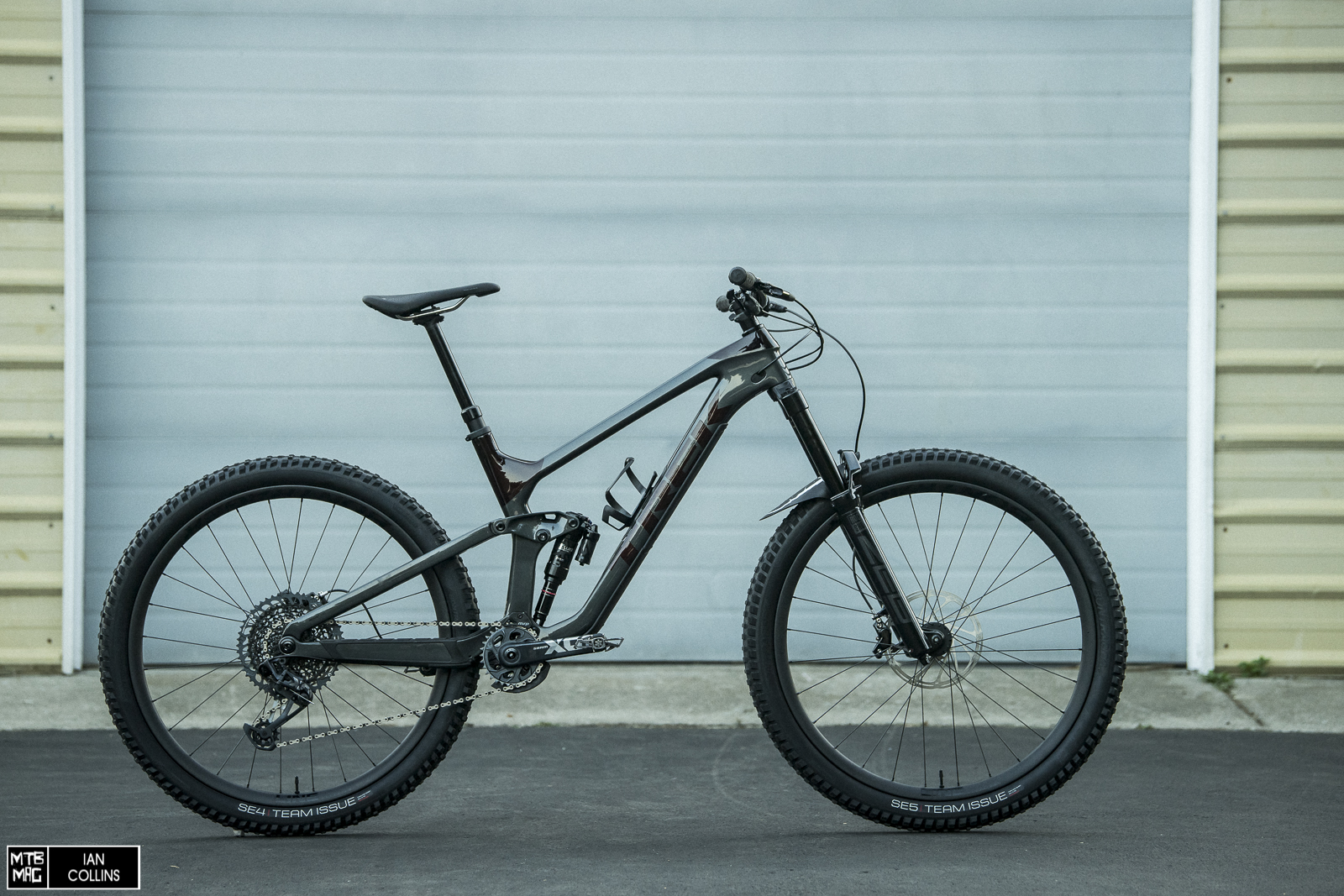
[Tested] 2021 Trek Slash 9.9 XO1
It’s been quite some time since Trek last updated the Slash – four plus years ago to be a little more precise. Since the last iteration was released, there have been enormous changes in the trends popular amongst bikes in the Enduro category. Perhaps the biggest refinements have been to geometry, and unsurprisingly the new Slash has undergone major tweaks in that arena. With that said, the bike also sees a plethora of other updates such as the inclusion of downtube storage, a radically different rear shock, a 10mm front/rear travel bump and a host of other subtle and not-so-subtle changes. For the last few weeks I’ve been getting to spend a great deal of time on the new bike at Silver Mountain in Idaho. Rough and ragged with descents nearing 4,000 vertical feet per lap, Silver has made the perfect testing ground for the hungry new Slash. Read on to see how it’s been working out…
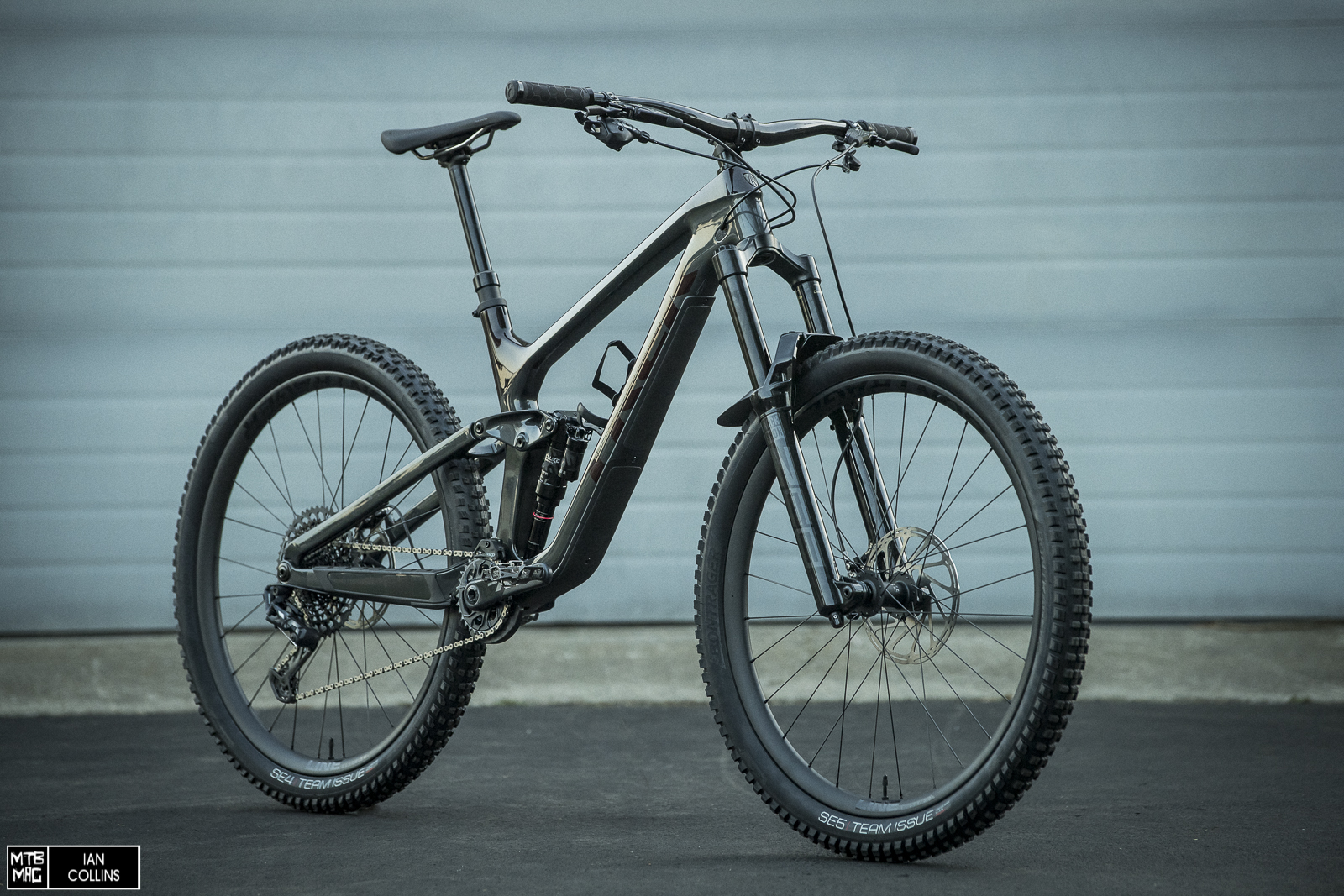
- 29″ wheels only
- Boost front and rear hub spacing
- Metric shock sizing with trunnion upper mount
- 170mm front travel / 160mm rear travel
- ABP (active braking pivot) suspension layout
- Mino-Link flip chip for adjustable geometry
- SRAM Universal Derailleur Hanger
- Internally routed cables / hoses
- Knock Block 2.0 with increased turning radius
- Downtube storage
- Full downtube protection
- 32 pounds (tubeless, no pedals)
- $ 7,999.99 USD

Starting with suspension, up front we see the all new RockShox Zeb with 170mm travel and a 44mm offset crown. With burly 38mm stanchions, the fork feels nearly as stiff as a BoXXer double crown fork. Like most RockShox offerings, it has externally adjustable high and low speed compression with a single rebound adjuster via its Charger 2.1 cartridge. An all new industrial design, the option of an integrated fender and a bottom out indicator are a couple of other new features.
We could dedicate an entire story to the new rear shock but we’ll try to keep it brief. Gone is Re:Aktiv, a technology co-developed with Penske to improve pedaling performance. Thru-Shaft still remains, and this new version of the shock is based around a RockShox Super Deluxe Ultimate. Okay, so – Thru-Shaft offsets shaft displacement by having the shock’s shaft literally exit through the bottom of the shock as it cycles through its travel. This means that the shock’s reservoir and thus its internal floating piston are now mainly concerned with temperature management as opposed to also dealing with shaft displacement. In lieu of Re:Aktiv, is a standard shimmed damper (Hallelujah!) which now has a simple 3-position adjuster to help tune out pedal input. It’s not really an open / trail / lock style setup, but rather three broad settings of low speed compression. This adjuster controls the extent to which a shim blocks an orifice that manages low speed compression on both the compression and the rebound side, and thus helps mitigate pedal bob cause by both compression and extension. More on the rear shock under “Setup”…

A handful of features, both new and old. Clockwise from top left: KnockBlock 2.0 features a warmly welcomed increase 14º in steering radius, from 58º to 72º. It also no longer needs the frame bumper of old on the downtube. Much like the new Fuel EX, Trek has included downtube storage via a trap door under the bottle cage, which is a life saver all around. Like most Treks, the new Slash features Mino link, a flip chip that offers a .5º variance in head tube angle and a +/- 7mm adjustment to bottom bracket height. Lastly, Trek have also jumped on the bandwagon of stashing a multi tool in the steerer tube. Compared to the Specialized SWAT CC that this is seemingly modeled after, it does offer an expanded range in tools and an improved chain tool, although it is a pain to install and remove the unit as a whole.
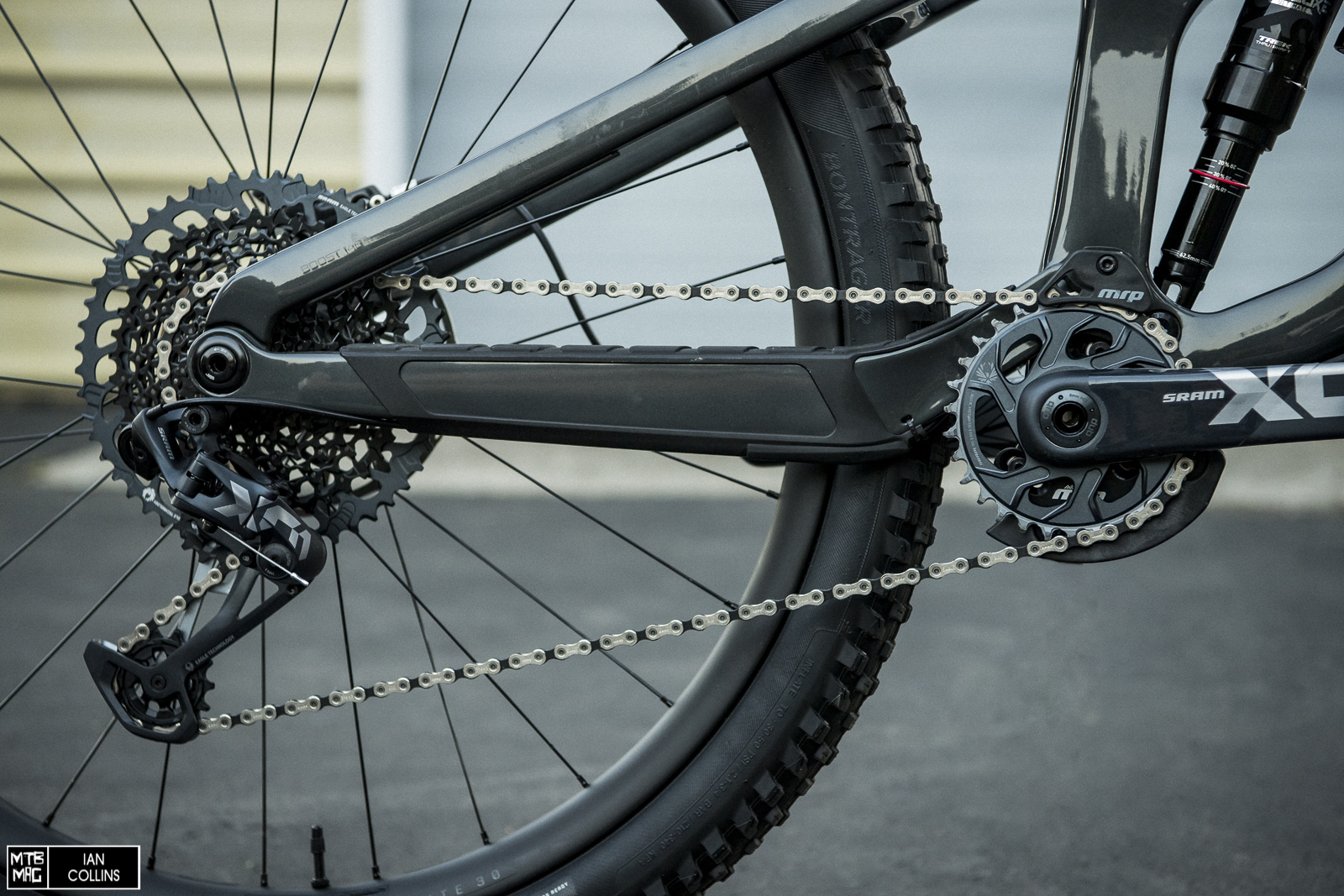
SRAM’s reknowned X01 Eagle 12 speed group is standard fare, albeit now with an expanded range due to a bump from 50T to 52T in the largest gear. Up front a 30T is spec’d to motor you up the big climbs on long days, and an MRP chainguide protects your investment. One thing we found odd is the choice of 175mm length cranks – on a bike this aggressive, we would have expected and very much preferred shorter 170mm cranks. Aside from that, much like we’ve come to expect over the last couple of years, the Eagle group has offered phenomenal shift quality and a huge range.
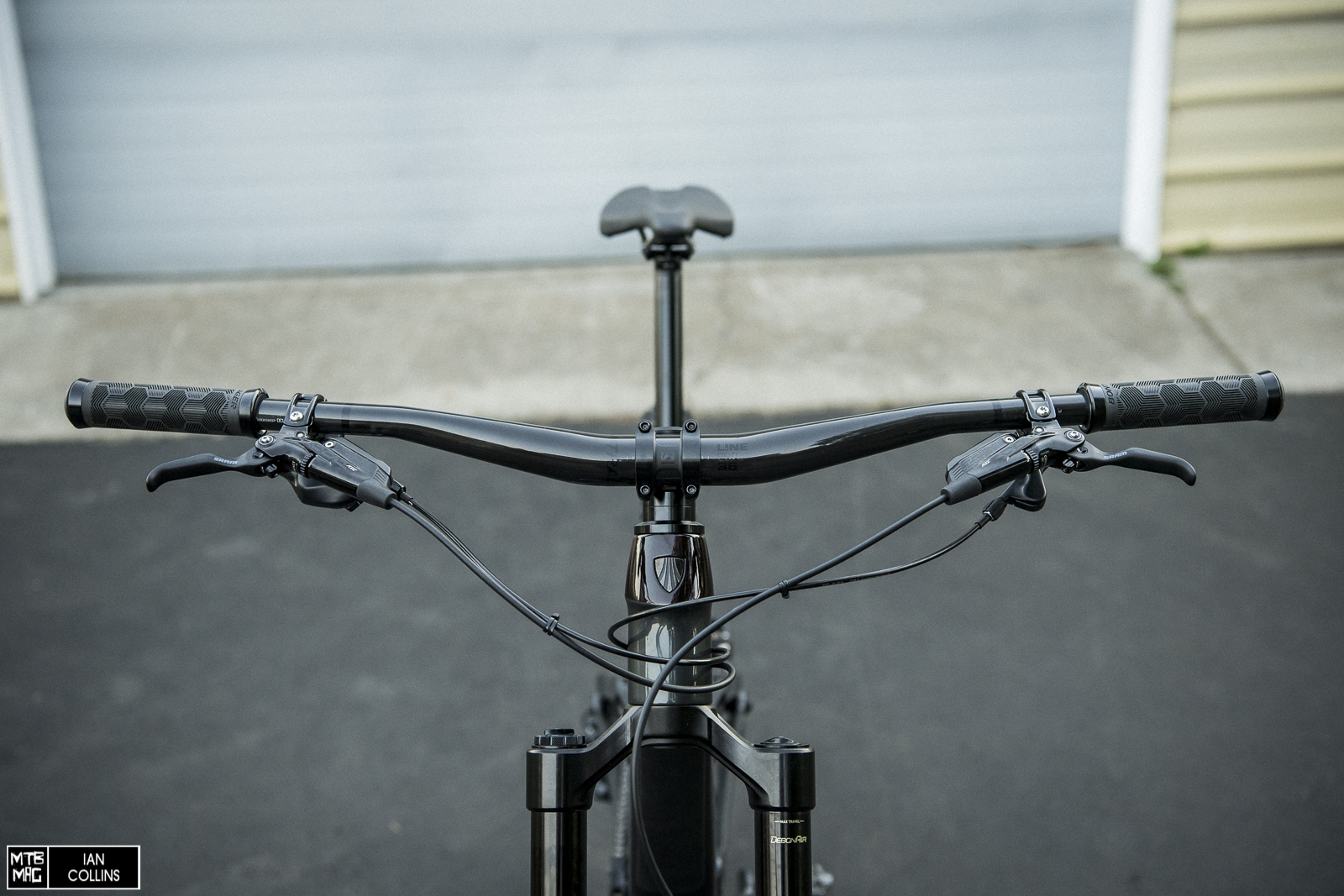
Up front, it’s mainly in house spec, starting with Bontrager lock on grips which were swapped for our trusty Sensus Meaty Paws. The handlebar itself is a crazy wide 820mm Bontrager Line Pro carbon fiber bar. It has a 35mm clamp and a 27.5mm rise. I trimmed the bar to 800mm, which was easy due to its guide marks. Lastly, the Bontrager Line Pro stem meshes nicely with the Knock Block system, although that does leave you relegated to 10mm bar height adjustments. Feeling like my hands were resting a bit too far behind the front tire’s contact patch, I switched the stock 35mm length stem for a 45mm and felt at ease right away.
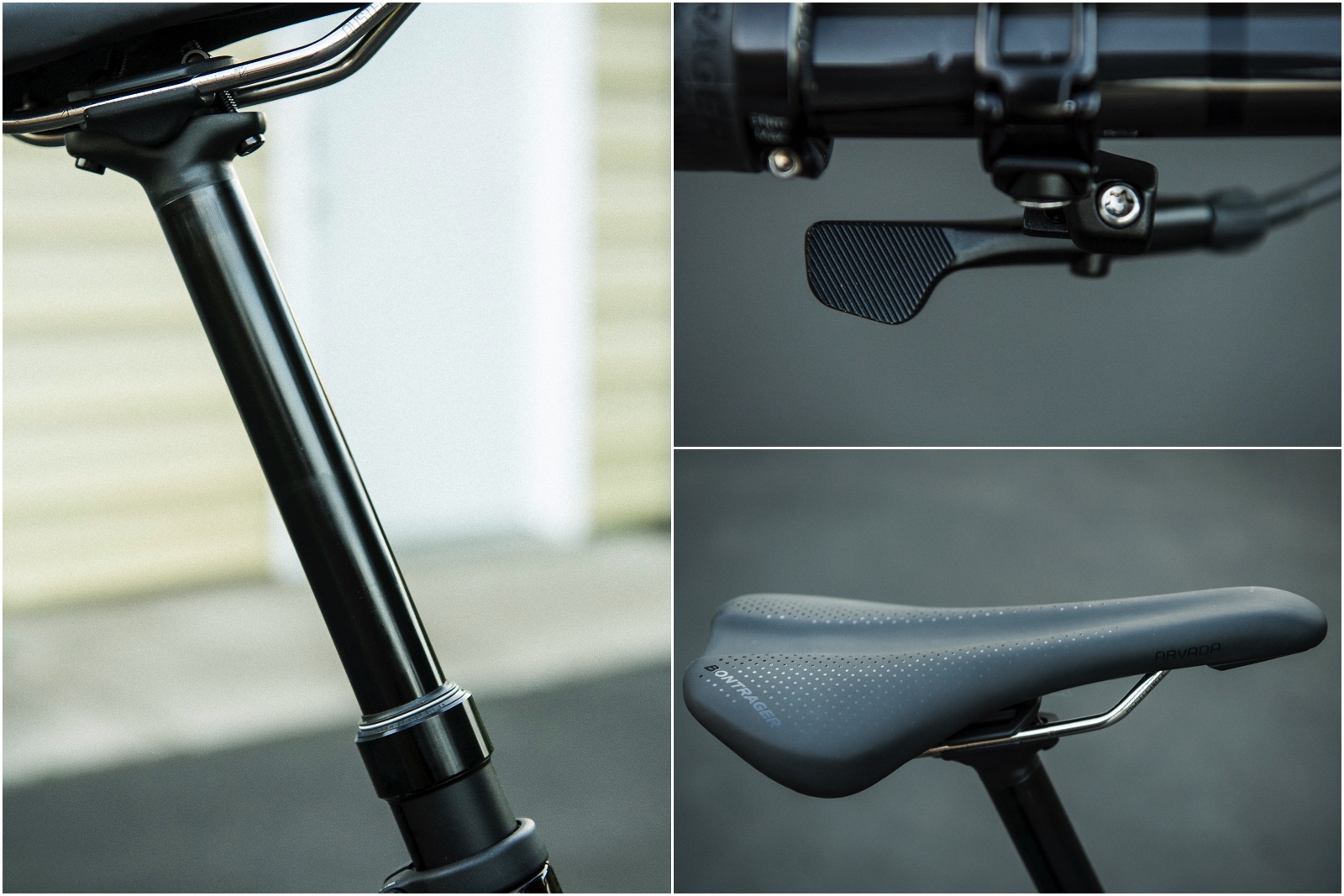
The latest version of Bontrager’s in-house dropper post has been exceeding expectations. Its action is smooth and it is stiff and supportive, due to the oversized 34.9mm diameter. As far as the lever goes, at first it seemed odd that it is placed so close to the handlebar, but I eventually took to it and realized that it helps you keep a better grasp on the grip when actuating it. The Arvada saddle had a good silhouette and just the right amount of padding, although it doesn’t seem to be all that rugged. All in all though, no complaints.
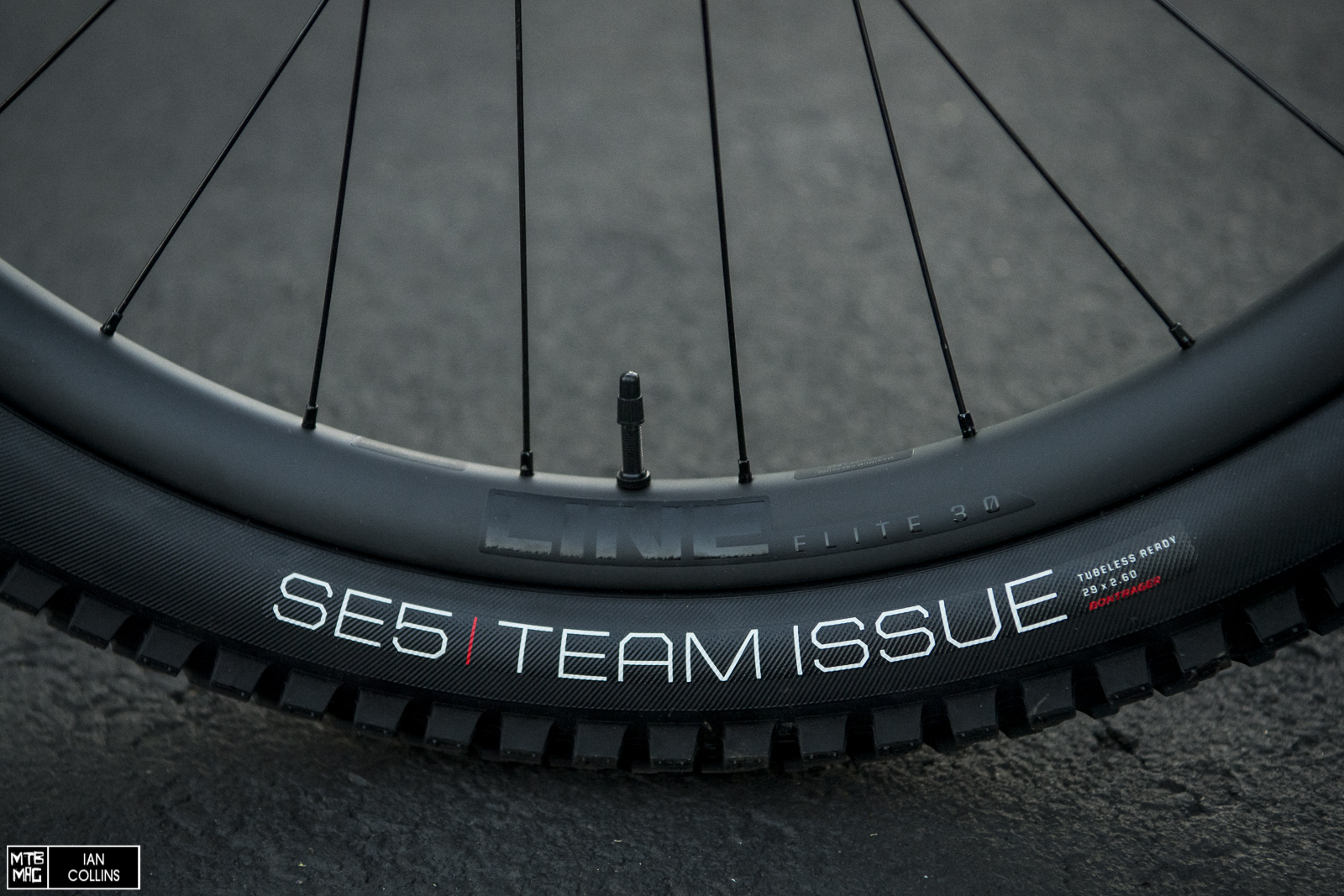
As one of the more high end models, we were happy to see Bontrager’s Line Elite 30 wheels spec’d on this model of the Slash. The 29mm inner diameter carbon fiber rims have seen an updated profile that is a bit shallower to help take the edge off and give them a smoother ride quality without compromising stiffness. Thicker rim walls provide better impact resistance while the 108 point engagement provides fast power transfer. As far as tires go, the SE5 / SE4 combination are decent tires, but I don’t feel they are up to the task that the bike is clearly capable of, on the whole. The bulk of my testing was spent on Schwalbes with thicker casings and a burlier tread pattern. Speaking of tread pattern, it’s been some years since we’ve seen anything new from Bontrager and in my opinion, they are past due…
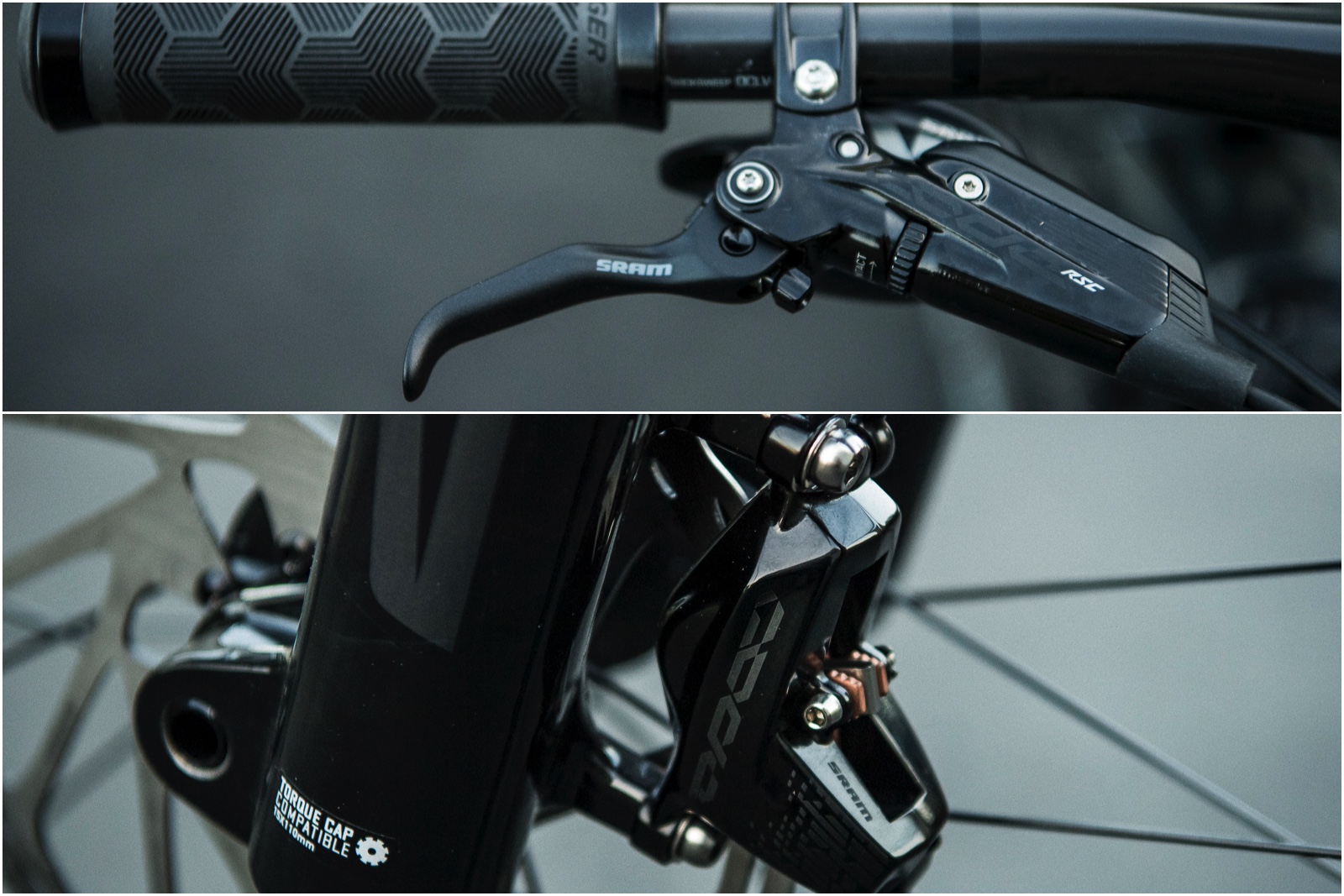
Last, but certainly not least, SRAM Code RSC brakes are tasked with slowing things down. These are my brake of choice on my personal bikes and I can’t say enough good things about them. The 200mm front and 180mm rear combo bolts up nicely with no adapters and gets the job done. Hard chargers who frequent steep terrain and/or long descents may want to swap up to a 200mm rear, but in stock form they should be just right for most riders.
While the new Slash sees a slew of new developments, the geometry updates are substantial to say the least. First off, the size range gets expanded from four up to five size offerings. The chainstay length hasn’t changed much, but the head angle has slackened one full degree and the BB dropped by a few millimeters. Speaking of angles, both the virtual and effective seat tube angles have been made steeper by a two full degrees for improved climbing. Lastly, reach numbers grew by roughly 25-30mm depending on the given size. All in all, the new Slash is a much more up to date bike with aggressive, but not ground breaking, numbers all around.
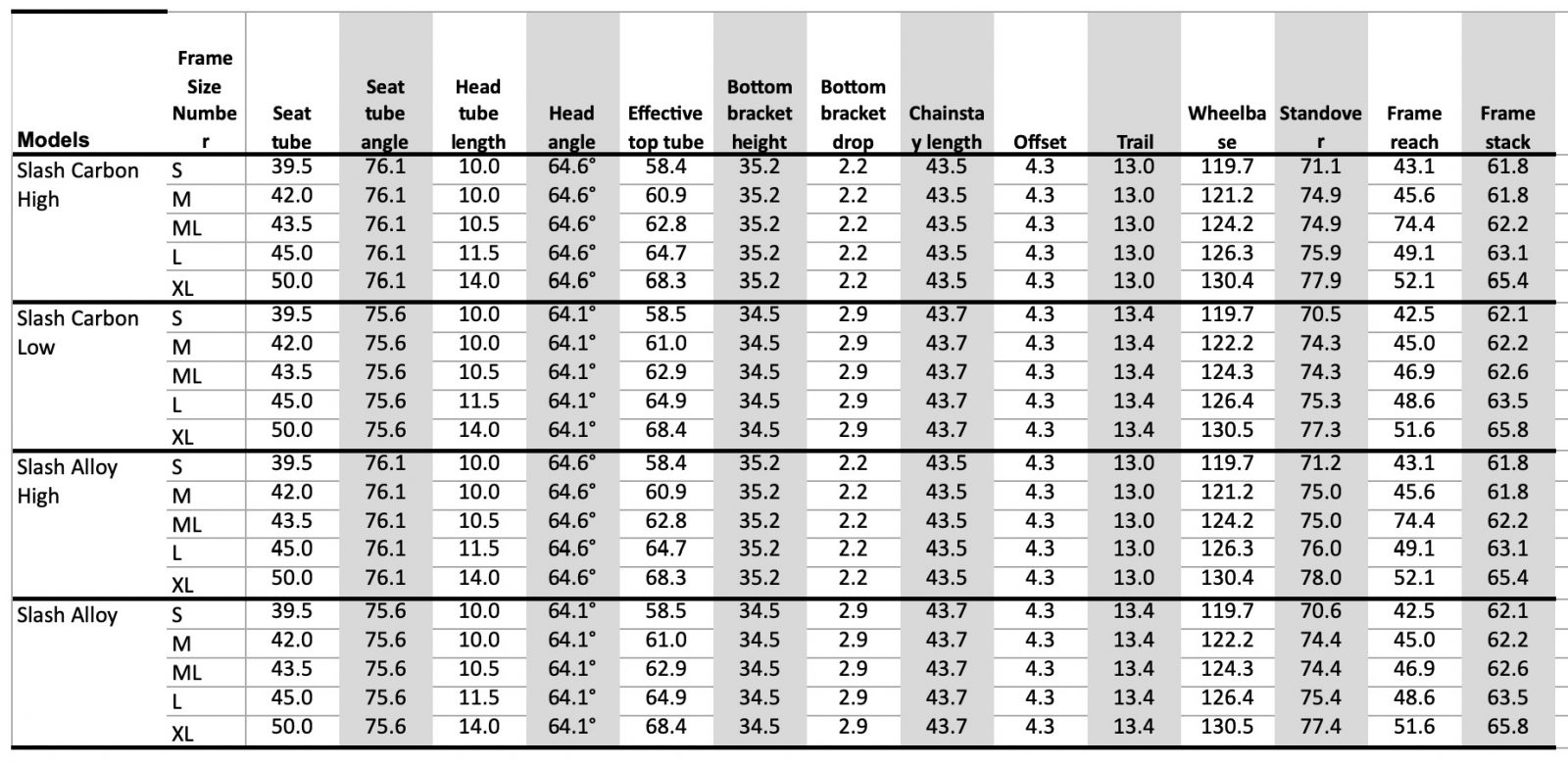
Starting with suspension, I began at my usual 20% sag up front and 30% sag out back, and to be quite honest I never once looked back because I was never compelled to. Straight out of the box, the suspension curve and progression rate was dead on, so aside from playing with rebound and the compression settings a tad, I never felt the need to add or remove volume reducers at any point. Keeping that in mind, this new version of the RockShox Super Deluxe with Thru-Shaft allows for one further element of adjustment – you can run zero or one negative air spring reducer, should you choose. This will essentially affect your off the top feel, being softer or firmer, respectively. Speaking of air springs, the new air can features a negative air spring volume that lands roughly between the standard Super Deluxe air can and a MegNeg – at least according to Chris Mandell at RockShox. On top of that, t he all new shock has some very interesting features – some of which could provide a glint into future products from RockShox. T he rebound dial is now numbered, and for what it’s worth I found myself right in the middle at the number 5 setting, which is spot on for a 180 pound rider. As far as cockpit goes, it was easy to get all dialed in with a longer 175mm travel dropper seatpost on my size Large, but I did wish I could have raised the handlebar a bit higher. Trek ships the bike with two 10mm spacers that are integral to Knock Block. For the taller, lankier riders out there it would be nice to see the steerer tube cut a little longer so that 3 spacers could fit. This means that I’ll need a taller bar or stem if I want to go any higher – a small matter, but worth mentioning.
On the trail
When testing a new bike, my initial saddle time is almost always spent on a climb as most of my time on the bike is pedal powered. With the Slash however, I was fortunate to squeeze in a great deal of descending (roughly 75,000 feet of vertical) in very short order, thanks to the fact that I now live just 40 minutes from Silver Mountain. Dropping into the upper trails you’re greeted by loads of super sharp rocks that are both loosely strewn about and firmly embedded into the dirt. As the trails dip down into the woods, as you’ll see in the video below, there are loads of roots, braking bumps and bomb holes. So while the area I tested in is plenty rough, it isn’t all that steep – not Santa Cruz loamer steep anyway. Silver’s borderline excessive mid-grade bench cuts and off cambers will make a full DH bike feel difficult to muscle around at times, but duty wise, the Slash turned out to be just right for this type of riding. So, how did it go?
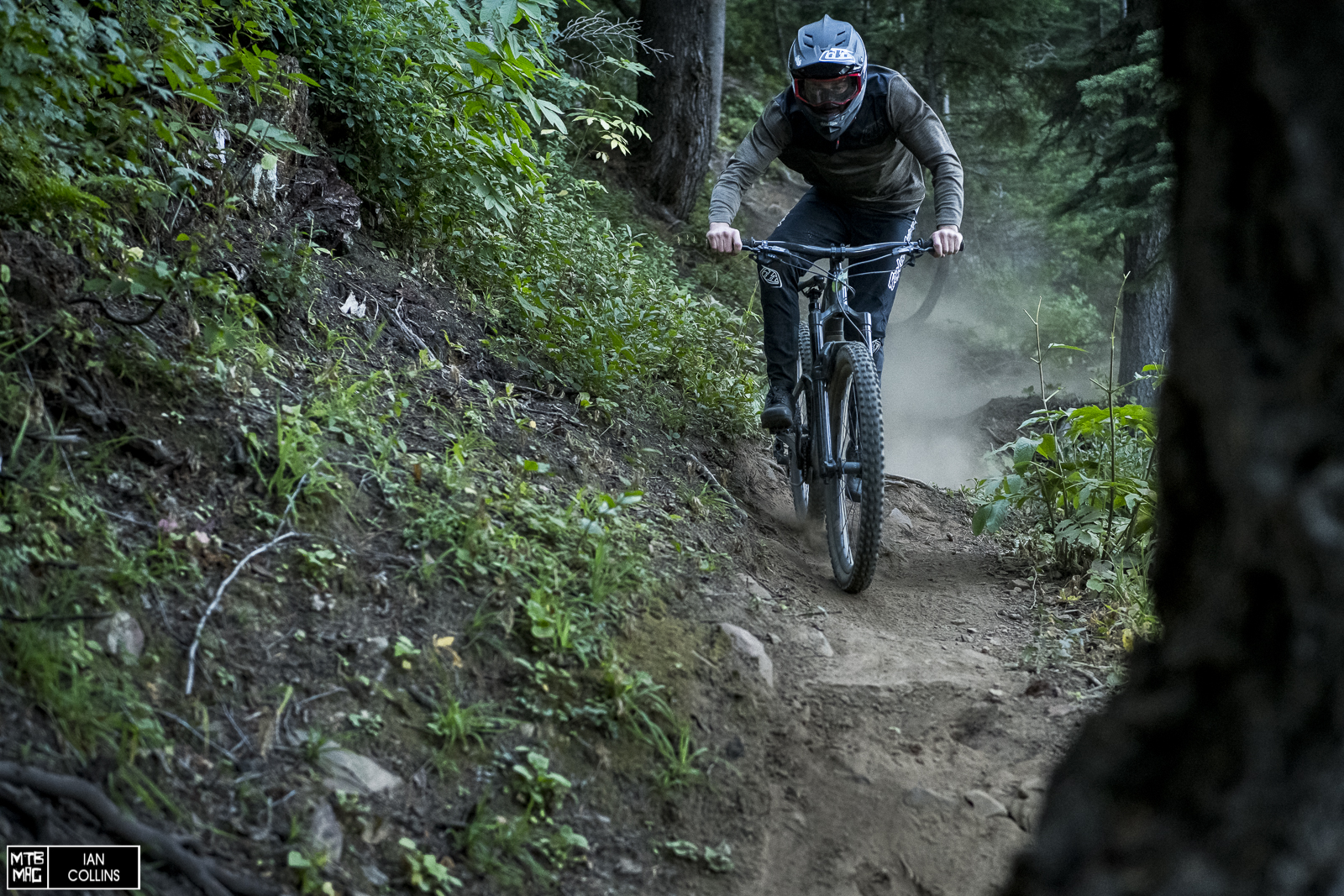
Well, straight away, up front I was very impressed by the Zeb and this was actually my first time aboard one. It felt very familiar as its Charger 2.1 damper makes the action feel a lot like a Lyrik or a Pike. The air spring’s lower operating pressures, which I was able to run in the 60 PSI range as opposed to the 90 PSI range, improved sensitivity. Perhaps that could also be attributed to its burly chassis, which definitely wowed me in terms of stiffness and steering precision. Getting to the frame itself, out back I’ve got to admit – I was never really a big fan of Re:Aktiv and I’m happy to see it gone. Its hydraulics interfered a bit too much as it tried to create the perfect bike that climbed like a hardtail without needing to lean on a lockout. To me, it always seemed gimmicky and inhibited the flat out performance as the pedal platform never quite “got out of the way” enough in the rough stuff. This is absolutely NOT the case with the new rear shock, which has totally won me over.
Now, before I continue heaping on praise of the rear shock, it’s worth pointing out that on the kinematic side, Trek’s engineers have also done their homework and done it well. I’ve always felt that ABP has been one of the most compliant feeling layouts on the market, especially under heavy braking, and on the kinematic end it shines brightest in successive mid sized events such as babyheads, chunder, roots, braking bumps, etc. This bike carries on that tradition and does it better than ever before. With past Trek models that used Re:Aktiv, after just one ride, I often found myself pondering if it would fit a coil rear shock, hoping to get more compliance out of the actual shock itself. With the new Slash I never once felt the need for a coil, even on the aforementioned brutal 4,000 foot descents. So, this new RockShox Super Deluxe with Thru-Shaft sure seems like a whole new air shock altogether from RockShox. Regardless, the action was excellent with bountiful traction, plenty of control, just the right air spring curve and a nice range of usable adjustment both on the hydraulic and pneumatic side.
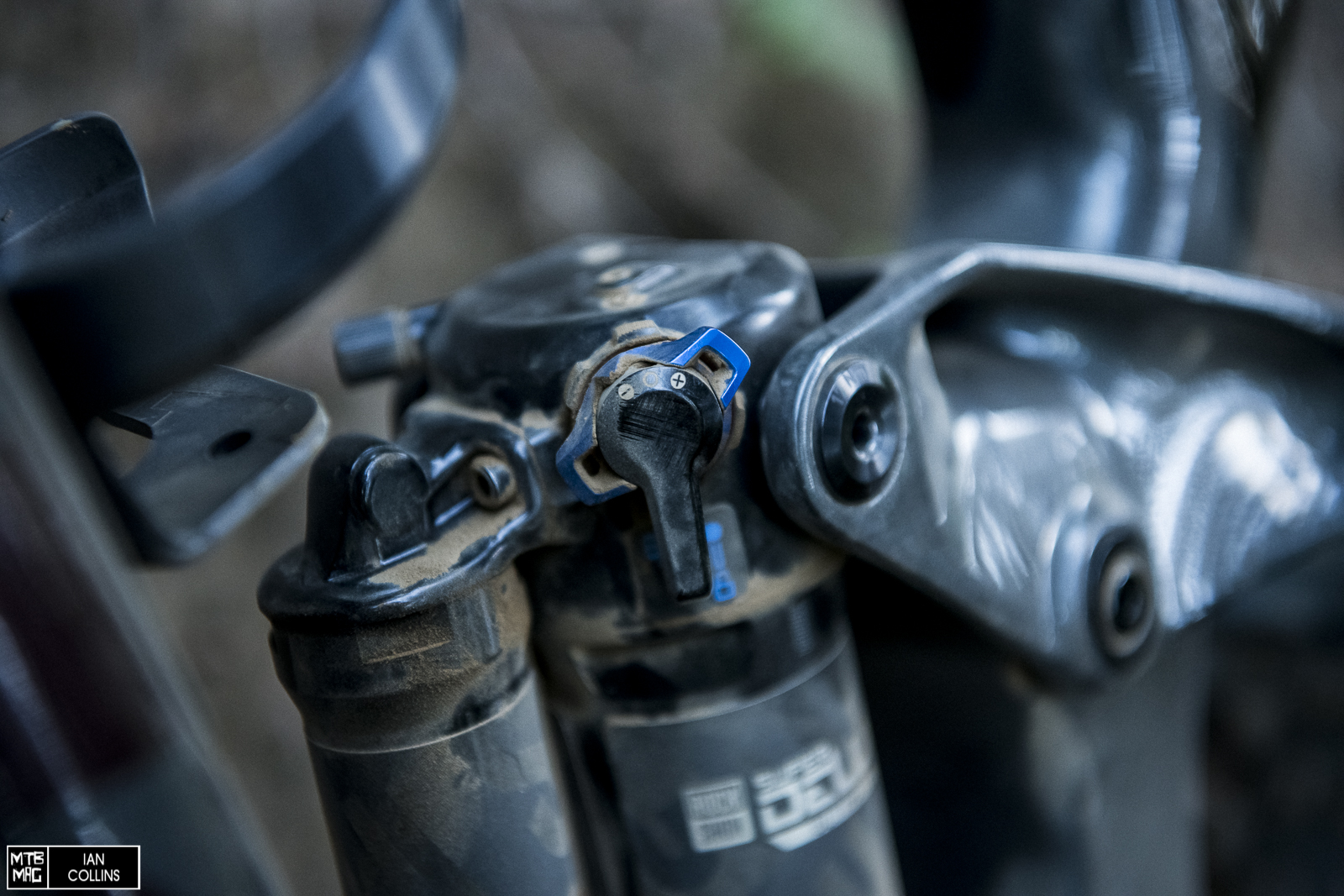
It’s worth discussing the new Low Speed Compression switch (in blue) for a moment. When doing park laps, I left it in the most open of the 3 positions and got all the traction I could ever ask for. Initially I started out doing laps in the middle setting and every so often I got the odd, perceptible spike now and again when transitioning from smooth sections to a first initial impact. I personally found that although the variance between the 3 settings is nowhere near as extreme as an “Open, Trail, Lock” style lockout, I preferred to use this lever in the same fashion. When descending for long periods of time, I left it fully open. When grinding up long climbs I left it in the *almost firmest setting – which by the way feels pretty compliant but pedals very efficiently. Note the shock has a totally firm lockout via the two-position black lever, I tested it out but never used really it – surely riders will appreciate it on fire roads though. Anyhow – on variable trails I just left it in the middle position. Lastly, I liked that the adjuster sits at 45º on the shock body, which makes it easy to reach while riding. Left handed riders will like it even more based on its position.
Okay, so the suspension flat out rules. What about geometry, handling, features and all the other important stuff? Beginning with the former, I actually started out and hardly strayed from the higher / steeper geometry option due to the longer 175mm cranks. While I can’t fault the ride quality in this setting, I could certainly see myself and others taking advantage of the lower / slacker option on steeper and faster terrain, so it is great having the option, but I would personally prefer to go down that road with shorter cranks. On the whole, the Slash has made leaps and bounds and landed right about where a modern Enduro bike should be, geometry wise. The front:rear center length ratio is just right, making it well balanced front to back. The bike is easy enough to manual and get around tight corners, but doesn’t give up much in terms of stability. The head angle is just right – a bit more nimble and sprightly in the high position. In low/slack it is detuned and desensitized to speed a bit more, but does flop a touch more on the climbs, which is to be expected.

If I had one complaint it was that, although Trek steepened the seat angle by 2º, in my opinion they could have taken that further still, to make for a bike that puts your body in an even better position to grind out climbs all day, regardless of the fact that you’re basically on a downhill bike. A ~75.75º (average) effective seat angle is nothing to scoff at, but I’d love to see it more like 77º. Then again, I’ve got long limbs and a short torso, and riders with opposite and/or more average proportions won’t be as phased, because they won’t require such a tall seat height and thus will sit further forward.
In terms of the overall handling, I can’t think of a single negative attribute. This is partially credited to the aforementioned geometry and suspension, but also a nod is very much due to the frame’s excellent layup and construction, which makes it just rigid enough without riding rough, and helps it boost when you need to get it off the ground. Despite being a long travel bike, Slash assertively walks the line between surefooted confidence and a sprightly, poppy demeanor. It’s easy to both hold the line and change the line in a millisecond. I went into this review thinking it would feel like a lot of bike, but it didn’t. At 32 pounds it’s actually pretty light weight when you consider just how much bike this is, and that it picks up roughly a pound from its full coverage chain guide – something that also earns the product managers the tip of a hat.
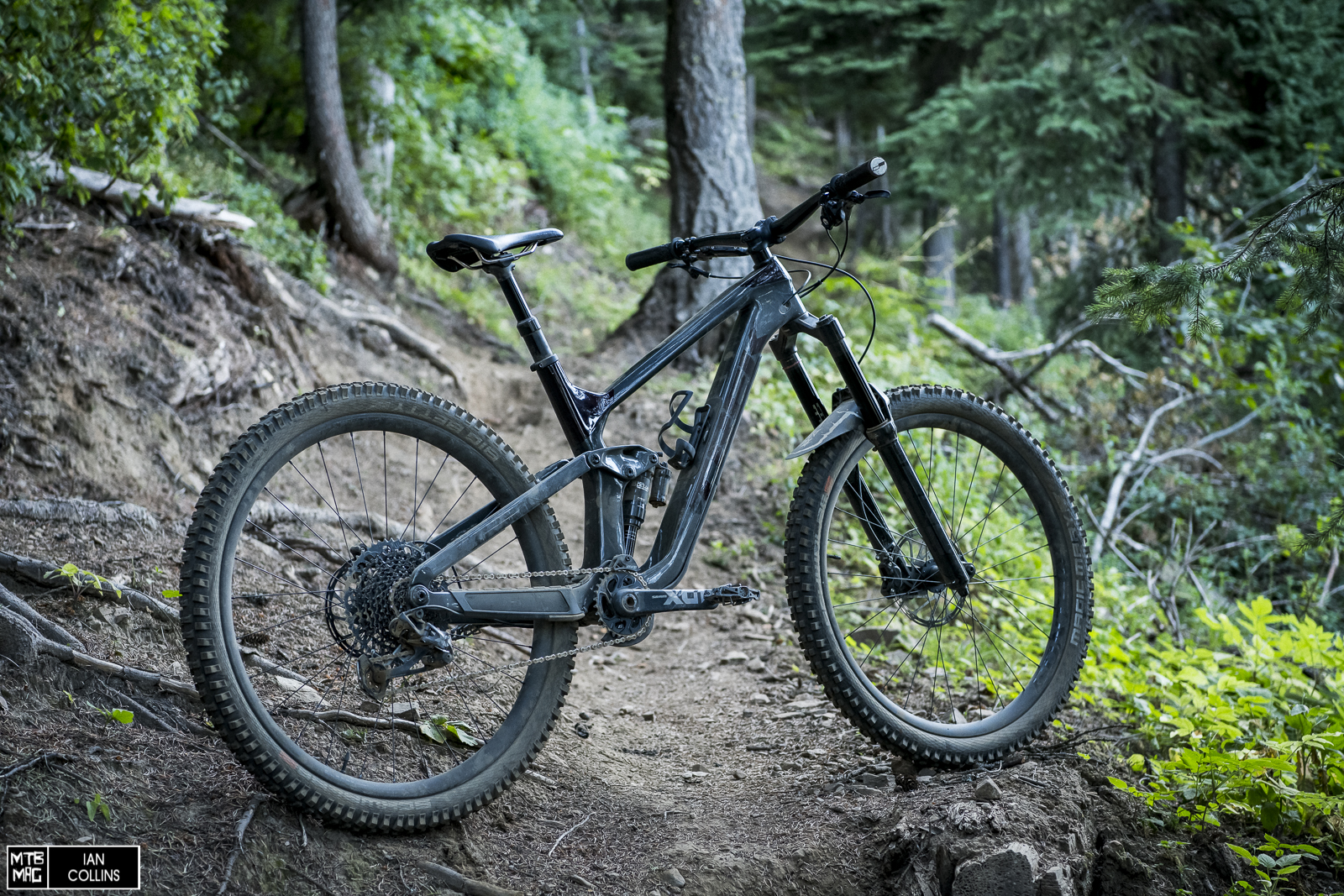
Regarding spec, for the most part I think Trek has done a stellar job at picking out a good mix here. The Zeb fork is a standout and both the Eagle drivetrain and Code brakes have earned high praise from us over the years, so I won’t drone on about them. Grips aside, the cockpit leaves little to complain about despite being fully in house parts from Bontrager. I quite liked the revised dropper post – it was smooth and less flexy on the climbs due to the oversized 34.9 diameter. The wheels have proven, like their slightly more expensive counterparts , to be really damn good. I had more than a handful of scary rock to rim impacts that had me pulling off trail to assess the damage, only to find none. Central to wheels, there was the issue of tires which I went over in “Details” – simply put, more aggressive riders will likely want to swap them out on short order.
As far as the noteworthy Trek/Slash specific features go, I will say that these days I’m much more of a fan of Knock Block than I once was. First and foremost, with the increased turning radius, now you straight up don’t even notice it. In fact if you do notice it while riding, it means you’re likely just about to hit the deck. And this is where it’s most beneficial. Since my first time riding Knock Block about 4-5 years ago, I have had one rather dramatic crash which resulted in a split brake line on a bike without Knock Block – the brake line split from the bars spinning too hard without a steering stop. On my very long walk home I spent a great deal of time talking to myself and thinking that maybe Knock Block isn’t that bad after all. In terms of the downtube storage, it’s obviously brilliant – in fact, it makes it very hard to go back to other systems where you’re relegated to stashing odds and ends on your bike.
So, aside from a couple of minor grievances – long cranks, flimsy tires, seat angle could be *slightly* steeper – the Slash is a super impressive machine. Every single attribute has been greatly improved over the past model. It’s very manageable for long days in the saddle with big climbs, but where it shines most is when things get rough…really rough. It absolutely gobbles up impacts of all speeds and sizes flawlessly. Both front and rear it was supple, sensitive and full of traction. It’s near impossible to get it to misbehave in the successive mid-sized hits, and on heavy impacts I used all the travel often and the o-rings just kissed the bottom out indicators – but I never felt one single harsh bottom out. It was the suspension performance above all that impressed me, and the handling came in at a close second. Sprinkle in smart features like downtube storage, Knock Block plus little things like the shuttle guard and you have a winner.
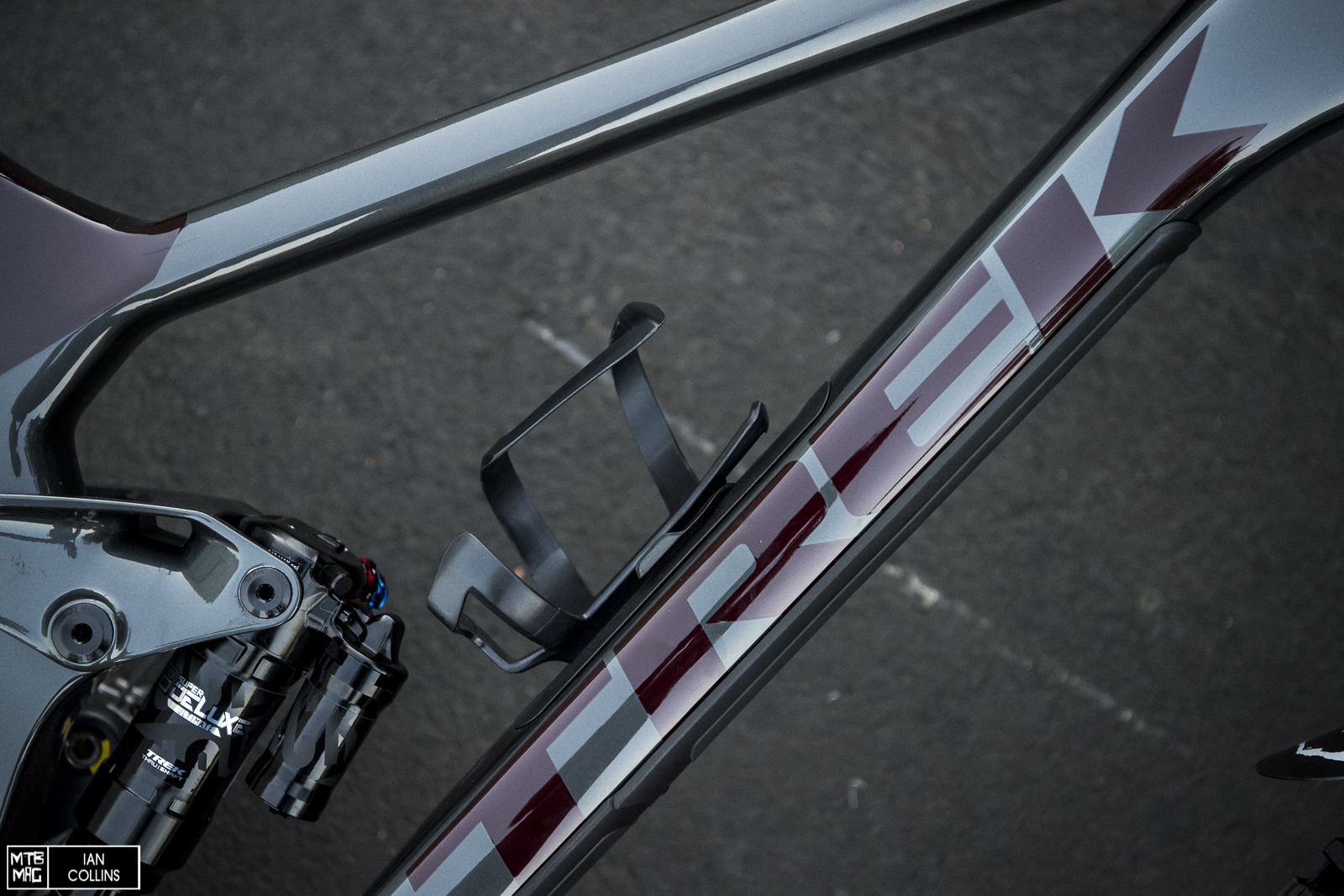
In my closing thoughts I always factor in value and yes, $7,999 is a lot of money for a bike, but it’s par for the course when it comes to flagship spec, and this specific model features a damn good parts pick, with carbon wheels and no major corners cut. If this model would leave your wallet too light, just know that there is a full range of new Slashes at a wide array of price points and aluminum frame options – consider the Slash 8, which packs an amazing punch at $4,000. Last but not least, props to Trek for including the downtube storage feature on those aforementioned metal models as well. All in all, the Slash is a bike park monster and would be an excellent candidate for a privateer racer as well. You’d be a fool not to consider one if you’re in the market for a new Enduro bike.
www.trekbikes.com
You might be interested in

[Video] Trek Factory Tour via Drone
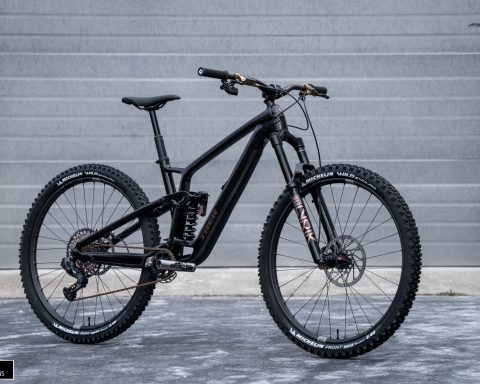
[Dream Bike] Trek Fuel EX
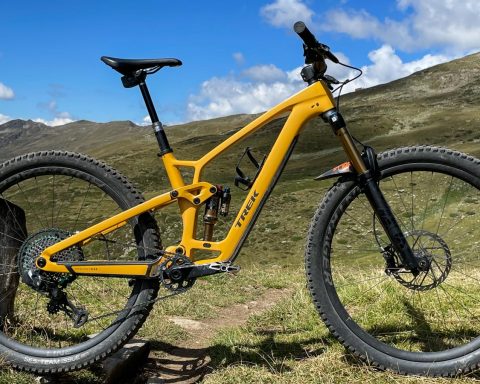
Trek’s 2023 Fuel EX Reviewed: Options, Options, Options…
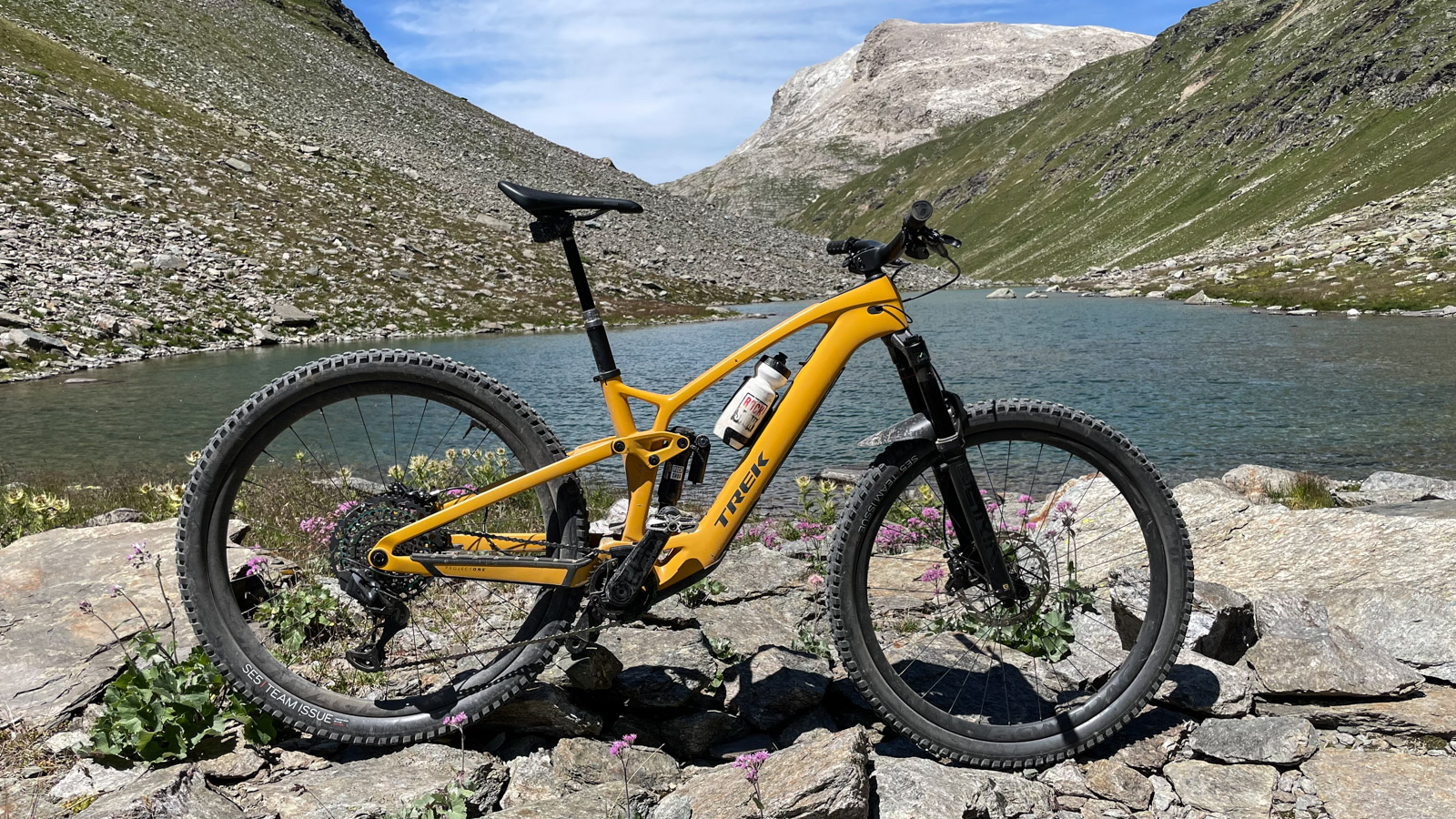
Trek Fuel EXe: The Most Analog of E-Bikes
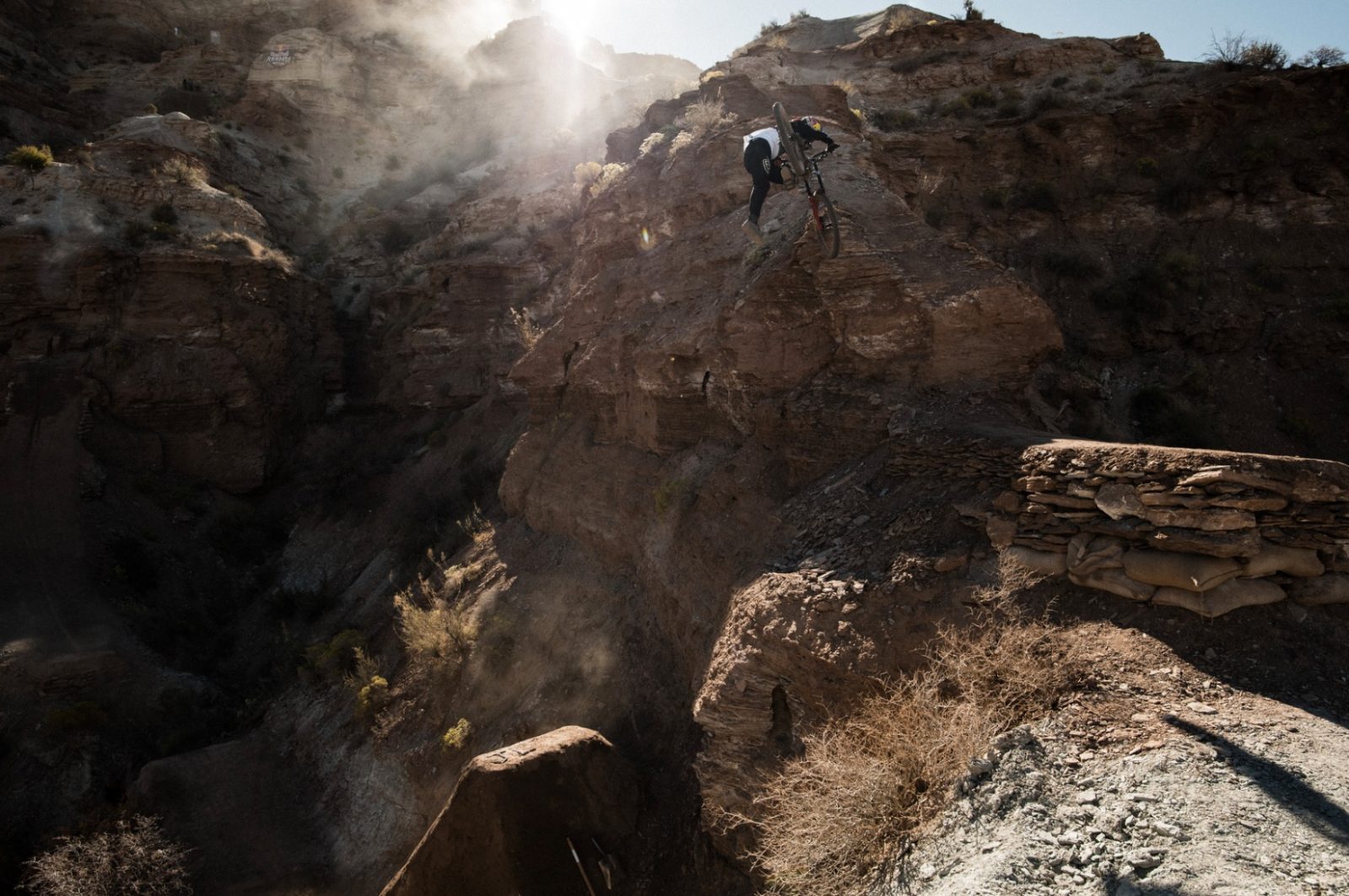
Red Bull Rampage Plans 2020 Cancelled
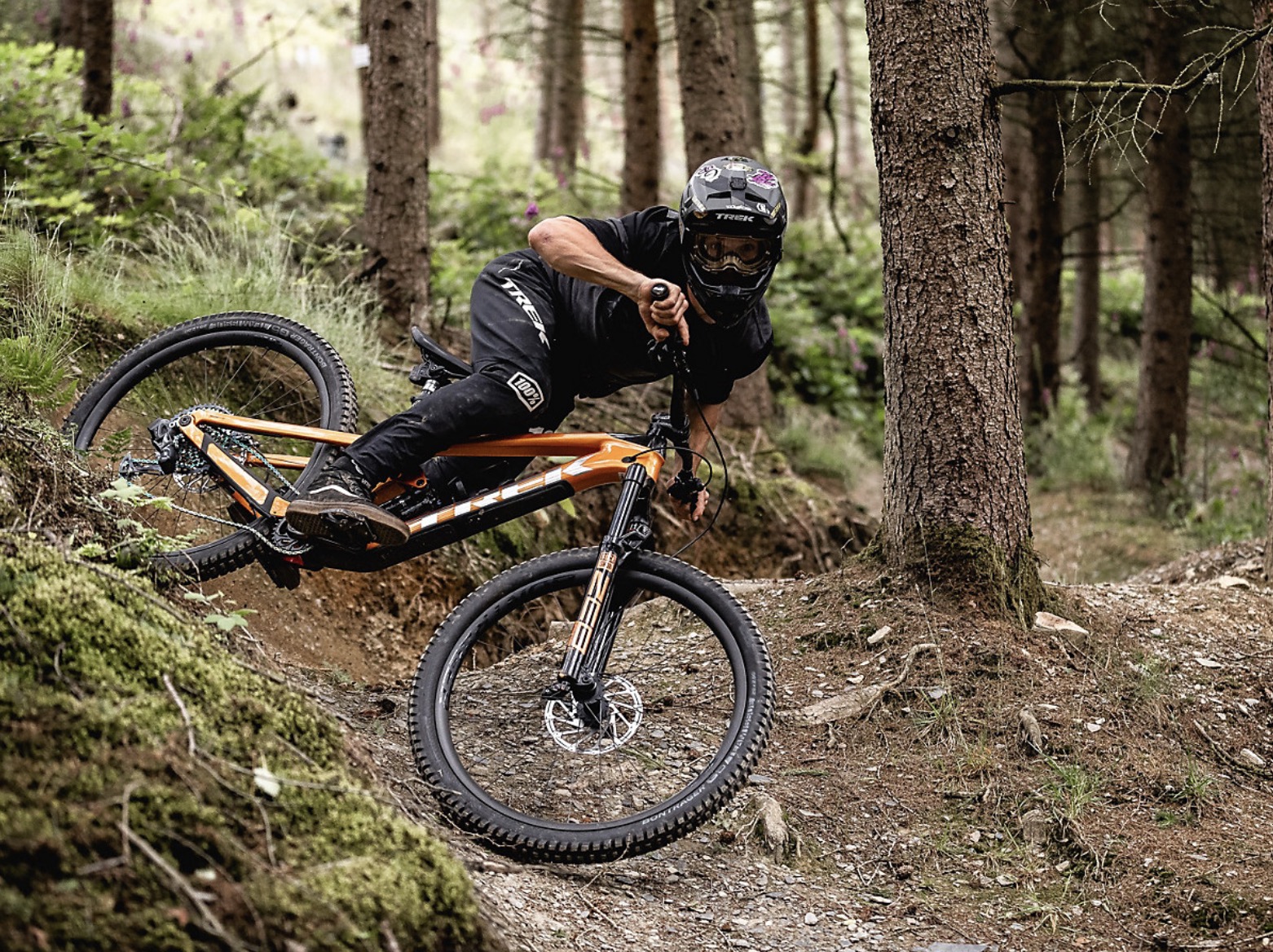
[Video] Semenuk, R-Dog, Casey, Flo & Kade Rip the Slash
Latest from reviews.

[Review] Roval Traverse HD Wheelset
Late this Fall and throughout an unusually warm Winter I’ve been spending time aboard my personal…

[Review] Specialized Epic 8 Evo
Specialized presents the new Epic 8, and with it the Evo version, i.e., the one with…

[Review] Scott Voltage
Scott introduces the Voltage, a light ebike with TQ motorization, a built-in 360Wh battery, 29-inch wheels,…

[Review] New Canyon Spectral CF
Canyon introduces the new Spectral, which is one of the most multi-purpose bikes on the market.…

[First ride] Cannondale Moterra SL
Cannondale introduces its first light ebike, the Moterra SL, and it does so in its own…

Shop in-store for even more deals!
Shop in store for even more deals we can't advertise!
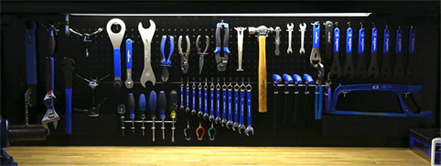
Mountain Bike Suspension Service
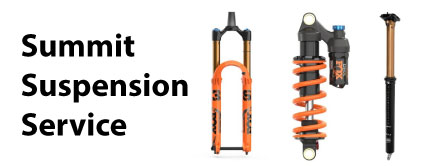
Trade In Your Bike

- Base Layers
- Mountain Bike Shorts
- Bibs, Tights + Knickers
- Mountain Bike Shoes
SAFETY GEAR
- Adult Helmets
- Youth Helmets
- Road Helmets
- Casual Wear
- Road Bike Shorts
- Bibs, Tights & Knickers
- Road Bike Shoes
- Accessories/Parts
Safety Gear
- Women's Helmets
- Road Bike Helmets
- Mountain Bike Helmets
WHEELS & TIRES
- Road Wheels
- Mountain Bike Wheels
- Mountain Bike Tires
- Wheels Accessories and Parts
- Derailleurs
- Chains & Cassettes
- Cranks and Chainrings
- Bottom Brackets
- Cables and Housing
- Power Meters
BRAKES & PEDALS
- Clipless Pedals
- Flat Pedals
- Mountain Bike Brake Sets
- Mountain Bike Brake Pads
- Road Bike Brakes and Pads
- All Brakes/Levers/Pads
Forks & Cockpit
- Grips and Bar Tape
- Rigid Forks
- Suspension Forks
Accessories
- Car Rack Accessories
- Electronics
- Front Lights
- Tail Lights
- Locks/Security
- Media/Resources
- Bicycle Mounted Racks
- Pumps/Inflation
- Tools/Maintenance
- Trailers/Strollers
- Trainers/Rollers
- Travel/Storage
- Water Bottles & Cages

Brand Guides
Bike buyer's guides, gear guides, new bike releases, summit bicycles online (855) 245-3663 [email protected] email, burlingame (650) 343-8483 [email protected] email, summit outfitters (408) 878-3252 [email protected] email, los gatos (408) 399-9142 [email protected] email, san jose (408) 264-2453 [email protected] email, palo alto (650) 304-0035 [email protected] email, summit bicycles mobile we'll come to you schedule mobile service today, (855) bike-one - for online orders and rental inquiries.
- Account Account
- Subtotal : $ 0.00 Checkout Cart
- Bicycling Catalog
- 29-Inch Wheel (29ers)
Trek Slash 8
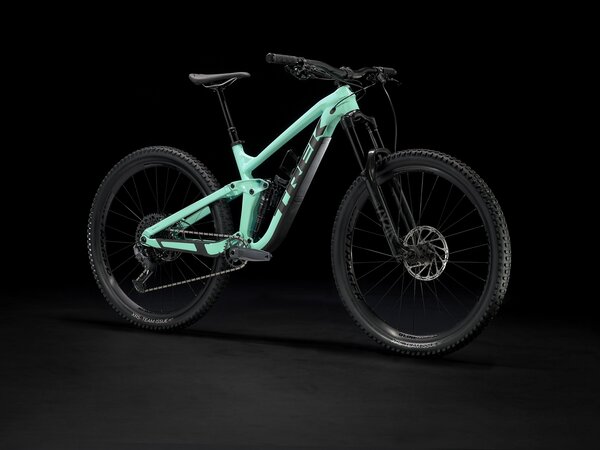
Slash 8 is an enduro mountain bike that rolls on fast 29er wheels and floats on plush RockShox suspension with SRAM's newest GX Eagle handling drivetrain duties. An aluminum frame with fresh new tech and tough alloy wheels push this bike into the sweet spot for all-around rippers. It's right for you if… You want a big bike with big wheels to roll over big things and send big hits. You might enter some enduro races, but you mostly just want to rail sketchy descents faster than anyone else in your crew. The tech you get An aluminum frame built for harsh riding with a threaded bottom bracket, dual downtube guards, Knock Block 2.0, and 160mm of travel with a RockShox Super Deluxe Ultimate shock for long descents and 170mm RockShox Lyrik Select+ fork. Plus, a SRAM GX Eagle drivetrain with an extra-low 52-tooth gear, Code R 4-piston brakes, and completely tubeless Line Comp 30 wheels. The final word Slash 8 puts serious enduro performance within reach with smart choices on spec that won't empty your wallet. The aluminum frame, burly suspension, and 1x12 Eagle drivetrain makes for a ride that's equally at home on the race course and on a big, backwoods session. Why you'll love it: - A sleek internal storage compartment gives you a versatile spot to stow tools and gear - We added a second down tube guard to better protect your frame from shuttle-related damage - It's equally at home between the tape and in the rugged wild-Yes, Slash is a race bike, but it's ridiculously fun on gnarly trail rides, too - New, removable Knock Block has a bigger steering angle to keep cables and hoses safe without sacrificing turning radius - Wider seat tube, wider dropper-the 34.9mm diameter post is stronger, more durable, and moves up and down faster
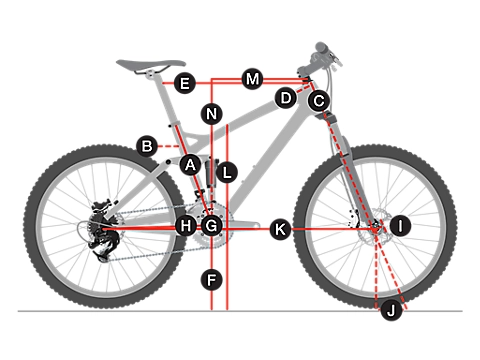
Due to supply-chain issues, Specs are subject to change without notice.
* Subject to change without notice.


- Forum Listing
- Marketplace
- Advanced Search
- Mountain Bike Manufacturer Forums
- Bike Manufacturers
2017 Remedy Knock Block Play
- Add to quote
I search this forum and came across another post... My bars will engage was seems like the limit of the knock block but then go another what seems to be 1/8 to 1/4". I've completely pulled the headset apart, cleaned everything with isopropyl alcohol. Relubed everything and reassembled but the issue still remains. There are what seems to be places where the paint/anodizing has rubbed off inside the top cap where it contacts the fork. The first spacer and cap are an extremely firm fit, unlike the two upper spacers which stack together without being forced. The actual chip in the frame doesn't appear to have any damage at all. Made a youtube video of what's happening: Anyone run into something like this that just a simple clean and reassembled didn't fix? Did it require a new cap from Trek? Also noticed at the LBS that just about every demo bike with a knock block seemed to have this issue as well.
Mine does the same thing and Trek has warrantied my complete headset twice and it still does the same thing. No one can figure out what is going on but it doesn't affect the steering at all and the fork doesn't come in contact with the frame. Sent from my iPhone using Tapatalk
I would move the spacers out from underneath the stem to above the stem and try again. Make sure that the stem is engaging with the HS top cap with no spacers in between. I'd venture to guess that what your seeing is due to intolerances in the spacers. Sent from my iPhone using Tapatalk
Yeah. There's a small amount of rotational play between the stem, each spacer and the top cap that add to allow a bit of rotation.
Video with just the headset cap, still some play in it: There is less play without the spacers, still get a lot of friction and getting the stem onto the notches of the cap is extremely tight. Seems like the tolerance between the knock block cap and steerer somehow became a bit too tight.
Video of the knock block hub assembly cap: Going to try and warranty through Trek tomorrow. Doesnt seem like it should be like this.
By the look of that tab, that would be why it seams like a lot of friction and tight to get the notch in the stem. Looks really distorted. Sent from my iPhone using Tapatalk
Hi boys. I have your same problems whith the knock block. Have you resolved it? Inviato dal mio SM-G930F utilizzando Tapatalk
The conclusion i've come to is that the bearing cap has a small ramp. There is not really any way to fix this other than to grind the ramp down. I would suggest keeping it lubricated because if you don't, the metal will wear and make the cap/spacers difficult to remove when you need to replace/do maintenance to the headset. All the bikes I own do this exact same thing: 2018 Slash Frameset (I ordered this as a frame and built the rest) 2017 Remedy 9.8 2017 Powerfly 8 FS Some are slightly worse, some are better... depends on which has the most wear. Almost all the bikes I checked at the bike shop seem to do it to some degree as well. There is no solution at this time that we have gotten from Trek or anyone else. Lubricating doesn't change the amount that I can turn it or how smooth it is. My guess is it's meant to slow the ramp to full lock. Doesn't make much sense but that's the only thing I can see. If you complain to Trek the best i've gotten is an offer of a new headset.
I get it. Thank you for your reply. Inviato dal mio SM-G930F utilizzando Tapatalk
Mine’s the same. I thought “they’re all like that”. Will need to keep an eye on it for sure.
Is this issue specific to 2017 or does the 2018 Remedy have the same issue?
Not an expert on this by any stretch but do you think the lock ring spacer may help this since it would only be 1 interface instead if 3? I believe it clamps on the steerer tube at the bottom of the stack and meshes with the knock block bearing cap.
There is a 2021 model trek slash. I had a small accident today. and i have the same problem.I opened the pieces. but there seems to be no problem. I'll go to the bike shop tomorrow and compare
gogo911 said: There is a 2021 model trek slash. I had a small accident today. and i have the same problem.I opened the pieces. but there seems to be no problem. I'll go to the bike shop tomorrow and compare Click to expand...
They all do this and it seems intentionally designed
There is a little bit of free play between each knock block spacer ring and the next. There are 3 spacer rings on my Rail 7 so it all adds up to a noticeable movement. If you draw a chalk mark down the stack of spacers, then turn the bars from one lock to the other, you'll see the chalk marks get slightly misaligned, then realign when you return the bars to the original position. The reason you feel a bit of resistance before hitting the limit is due to the friction between the rings. If it bothers you, try using less torque when you tighten the head stem cap.
Guys and Gals, let's face it. Knock Block ain't designed well.
- ?
- 15.6M posts
- 523K members
Top Contributors this Month
Explore More Areas
- Claim My Business
- Add My Event
- Add My Business
- Halloween 2024
- Thanksgiving
- Restaurants
- Things to Do
- Real Estate
- Photos & Video
Halloween in Saint Petersburg 2024
Are you a St Petersburg & Clearwater guru? Be heard and share your experiences by becoming an 727area.com Contributor. Learn More!
Get Connected!
Are you a local in the St Petersburg & Clearwater area? Join your community and Get Connected with others in your area. Join FREE!
- St Petersburg & Clearwater FL
- St Petersburg & Clearwater Events
Our Guide to First Friday: Downtown St. Petersburg's Biggest Block Party!
Every first Friday of the month, Downtown St. Petersburg turns into a giant block party to celebrate the start of yet another beautiful month in Florida. Central Ave. turns from a hipster hangout zone into the top party destination on any given First Friday. If you like listening to live music, meeting locals, and checking out new bars and restaurants, then head to Downtown St. Petersburg this Friday, August 2, and party like there's no tomorrow at their special All-American Bash.
On August 2, the block party starts at 5:30 p.m. and features live music from Southern Express, a local band that's been playing its unique mix of Contemporary Country, Southern Rock, and Rockabilly all over Tampa Bay since 1985.

Each month, there are featured beers and liquors for those who take part in First Friday celebrations to enjoy. This month's block party is sponsored by Yuengling and Tito's Homemade Vodka, so be on the lookout for special drink prices at many of the surrounding bars and restaurants. Either will get your juices flowing so you can dance the night away with Southern Express.
Now that we’ve talked about the two most important parts of First Friday (music and alcohol), we can talk about the coolest bars and restaurants to hit up while you’re out in St. Pete. Check out this list of our favorite bars in St. Petersburg to hit up during First Friday celebrations!
And for more fun events in St. Petersburg , return to 727area , your free local guide to Pinellas County!

Images courtesy of 813area.

Mandarin Hide

Thirsty First

Ruby's Elixir

Five Bucks Drinkery
Related posts in st petersburg & clearwater events.

Family-Friendly Things To Do for Thanksgiving in St Petersburg and Clearwater

Leave No Trace of Trash at Caddy's Community Cleanup

Things To Do in St. Pete This Weekend | April 30 - May 2

What To Do This Weekend Oct. 25-27 from St. Petersburg to Clearwater...and beyond!

Discover Innovative Health Therapies At CBD Health & Wellness Expo Tampa Bay

Top 10 Things To Do This Weekend in St. Pete and Clearwater | May 30th - June 2nd
Join my community, 727area.com would like to send you latest updates.
- Photographers
- Live Music & Bands
- Things to do
Business Toolbox
- Add Your Business
- Post Your Event
- Advertise with Us
- Business Directory
Connect with MyArea Network
- Sign Up Now
- Privacy Policy
Communities
- Clearwater Beach
- Downtown St Petersburg
- EDGE District
- Grand Central District
- Indian Rocks Beach
- Madeira Beach
- New Port Richey
- Palm Harbor
- Pinellas Park
- Safety Harbor
- St Pete Beach
- St Petersburg
- Tarpon Springs
- Treasure Island
- Family & Parenting
- Health & Beauty
- Business & Finance
- Arts & Theater

- Register New User
- First Looks
- Friday Fails
- Community Blogs
- Fantasy League DH
- Places Directory
Ditching the Knock Bloc

Cool Features
- Trek Knock Block Headset Spacers
We’ll make this a great experience
It’s our mission to provide you with world-class hospitality every time you visit us online or in-store. We’ll always take care of you. It’s the Trek way.
Awesome free shipping options
All accessory orders over $49 ship to your home for free, and all accessory orders ship free to your local retailer for in-store pickup.
30-day Unconditional Guarantee
If for any reason you’re not 100% happy with your online order from trekbikes.com, you can return it in like-new condition within 30 days. No questions asked.
- The Inventory
- Entertainment

Even After A Nerf, Shadow Of The Erdtree 's Final Boss Is One Tough Bastard
Thankfully, we have a comprehensive guide to get you through the game's toughest fight.
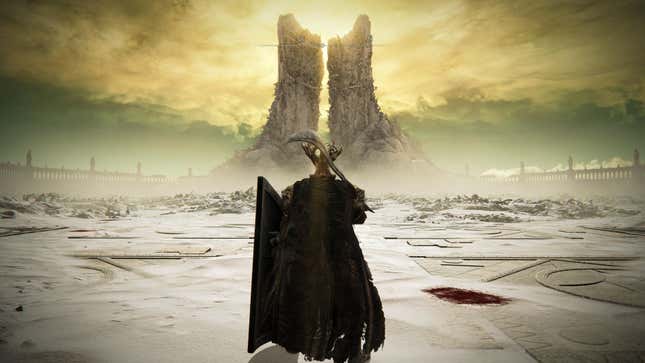
Shadow of the Erdtree warned you right at the outset that it was out to hurt you, and continue hurting you, but once you’ve burned down the Sealing Tree, and made it through the final dungeon, you just might be feeling pretty confident again. The final boss, Radahn, changes that. Immediately. Even after his recent nerf , this is one of the toughest gaming challenges you’re ever likely to face.
Suggested Reading
Related content.
Even more than Radagon and the Elden Beast in the base game, Shadow of the Erdtree ’s final challenge is the sum total of all lessons learned, because make no mistake, you will need to employ all of it to survive, and slipping up just once is typically enough to send you back to the Site of Grace with your tail between your legs. We can’t guarantee an easy time here. We can’t even guarantee a good time here. But we’ll tell you everything we know, regardless.
Preparation
Given just how extensively these two fights can absolutely fuck you up, preparation is a number one priority, because while there’s leeway in most boss fights to figure out how to fight your own way and still win, this is a very different story, and there’s certain things every player should consider before you even think of walking up those stairs.
- High Vigor is nice, but you’re gonna need as much raw defensive power as possible here. That’s less about softening blows, more about narrowly avoiding getting one-shotted if you take a hit. The Dragoncrest Shield Talisman can help, as can the Verdigris Discus Talisman for tanks, though, you’re gonna want to keep a medium roll, especially for the second part of this.
- If you fully completed their quests, and they aren’t, uh, downstairs from the boss room, Thollier and Ansbach will be available as NPC summons for this fight. However, tempting as it may be to have all the help you can get, bringing them both in will jack up the boss’s HP. As you’ll learn, you do not want this fight to drag on longer than it has to. In fact, most builds may just want to roll with a fully upgraded Mimic Tear and nobody else.
- You’ll want as much resistance to Holy damage as possible for the second part of this. Some armors will be better than others, and in a fight where two hits can kill you regardless, you can take the tradeoff in other stats. There is, however, one specific item you want to bring for this that will help the most: The Golden Braid, found in the Shaman Village in the Hinterlands. Not only does it feel like it was specifically made for this fight, but if you’ve been paying close enough attention, it’s a rather huge—and incredibly sad—piece of the lore puzzle.
- For Tanks in particular, either mix a Wondrous Physick flask that raises your max stamina and regenerates it faster, or equip the Two-Headed Turtle Talisman. Your stamina’s about to take a beatdown.
- Yes, this is the fight where Miquella’s Broken Rune comes into play, but as we’ll get into, the amount of time needed to use it may not, ultimately, be worth it. Still, if you don’t have faith in your dodge timing, it’s good to have it at the ready.
- In an ideal world, your Scadutree Blessing level is over 13, your Revered Ashes over 8.
- For weapons and spells: Bring anything that can inflict Bleeding, Scarlet Rot, or Frostbite. Bleeding is ideal, though, since building that up strips a big chunk of health off in one shot, usually enough to immediately trigger the next stage of the fight, and anything you can do to not get in an endurance match is a blessing.
- Speaking of: prayer probably wouldn’t be the worst idea.
Now then. Here we go.

Promised Consort Radahn Abilities
Hello again, friend of a friend. Now you know why you had to kill Radahn’s crazy, horse-abusing form first before you could even get into the DLC. Sorry to tell you though, Starscourge Radahn is small-time compared to his fully resurrected form. He’ll give you a good example right away, since the first thing Radahn does is launch himself at you with a spinning cyclone move which, for the vast majority of builds, is an immediate one-hit kill.
If you survive that, then it’s time for a swordfight. That’s not good news. Radahn’s Greatswords are the size of trees, and although his strikes can come in combinations of two to five, even with a tank build, every hit puts a massive dent in your stamina, and even if a Spirit Ash or summon manages to distract him, he can turn around on a dime mid-combo. That’s to say nothing of Radahn managing to land a clean hit, which can easily put you in critical condition. He’s got a couple of extra tricks up his sleeve on top of that. He can perform a somersault strike once or twice in a row. His four-hit combo ends with an overhead swing that buries his blades in the ground, with area-of-effect damage when he pulls the blades out. There’s a two-hit uppercut combo with the two blades that juggles you into the air if the first swing hits, and smashes you back down with the second. That’s also, typically, instant death.
On the magical side of things, aside from pulling out that spinning cyclone attack if he gets too far away from you, he can enchant his blades with gravity magic, leap in the air, taking chunks of the ground with him, and fire them at you as projectiles. There’s a two-hit combo that creates a bloody rift that hangs in front of Radahn and explodes in a few seconds. That explosion can inflict bleeding on you. And hey, just for old time’s sake, he’ll do a version of Starcaller Cry, except the gravity pull now does continuous sapping damage, and the explosion spawns deadly barbs that can wipe you out in two seconds.
Promised Consort Radahn Strategy
So, the big good news is, after FromSoft dropped that 1.14 patch, Radahn is a little kinder and gentler than before, but we’re talking the difference between getting hit by a train versus getting hit by a Jeep. At least one of those scenarios, the driver can slow down a little, and that’s exactly what FromSoft did to Dahnny Boy, compared to the unholy terror he was before. Thanks, Miyazaki.
There’s some more tiny good news for you: You only need to get Promised Consort Radahn down to about 70 percent health. Of course, the problem is getting even 30 percent of the man’s health down in the most brutal, relentless fight in the entire game. Seriously, once Radahn is in range, he will have his foot on your neck. Just about everything he does will wear down your stamina, your life bar, or both. Extending yourself to do damage is a risk every single time. As such, there isn’t so much a consistent winning strategy for Radahn so much as telling you how to deal with each of his attacks, and you have to make the call on how best to capitalize, and lucking out with his attack patterns plays just as big a role as sheer skill here.
The only other good news is that, if you listened to me with the Preparations section, if you can inflict one of the three status effects on him fast enough, this fight can be over a lot quicker than anticipated. Your Spirit Ash can help if used wisely, and I reiterate that the Mimic Tear is your best friend with this, just because having two of you doing the same damage in the same way can speed this up. I repeat: you don’t want this to turn into an endurance match. The HP boost Radahn gets from bringing Ansbach or Thollier into this will do just that, which is why you bring them in at your own risk.
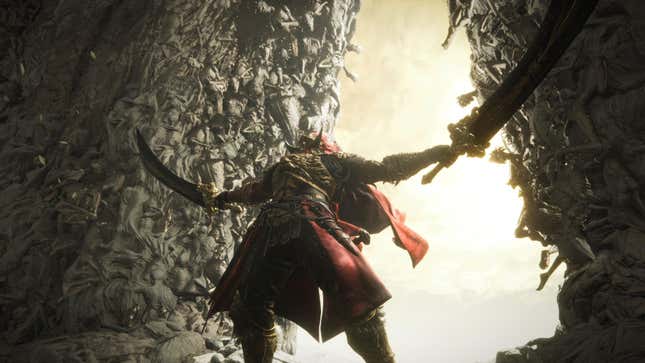
Here’s the thing, though: The most effective use of the Mimic in this fight requires a mental adjustment. See, most of the time using the Mimic or a summon, its job is to distract the boss while you sneak up behind and do the real damage. It’s the other way around here. You, personally, can adjust and deal with Radahn’s attack patterns on the fly. The Mimic cannot. And as such, your job is actually to pull aggro on yourself as much as possible, partially so your helpers can get some damage in, but mostly with the hopes of keeping your friends alive (and, ideally, with more than half health) for the second stage of this fight. You’ll see why later.
With those in mind, let’s go over seven different ways Radahn’s gonna try and fuck your shit up.
1) When you walk in, you’ll have a few seconds to call in your Mimic Tear before he comes at you with the world’s biggest Psycho Crusher. You can roll through that fairly easily once you see him leave the ground, but his next hit is coming the second he recovers.
2) Sword combos: By now, shieldless folks should have pretty decent common sense when it comes to rolling through combination strikes, and Radahn’s are big, but nearly all of them leave him open just long enough for a single hit. If you’re not a spell user, you’ll want to roll like you’re trying to get around his back. You won’t get there unless your Spirit Ash gets his attention, but it will get you out of harm’s way as long as you time it right. These are the source of your best openings to do damage or heal, however. There’s a fast two-hit combo where Radahn crosses his blades back and forth. Dodge forward on the second hit, and he’ll stand there in a crossed-arms pose for a second. His three-hit can come at any time. It’s dodgeable and blockable, but his follow-up might not be, and dodging or blocking it can leave you low on stamina.
His four-hit combo (single-blade right, dual blades to the left, followed by overhead slam) is the easiest to telegraph, but the AOE on Radahn pulling his swords out of the ground after the final hit has a bigger hitbox than you might expect for anyone trying to stay close. For shielded players, however, this bit is truly his best opening. After blocking the dual-bladed right-to-left strike of that combo, roll around the overhead smash to get clear. If you’re ambitious, close enough, or have the stamina and poise for it, though, you can block the AOE, and guard counter it. He runs with this combo quite a lot, typically, so it’s not out of the realm of possibility to punish him for it enough that you stagger him. Now, that’s pretty dope if you can make it happen, but fair warning that ripostes don’t even knock him on his back. He’ll be coming for you with a vengeance the second he gets off his knee, ripostes cost stamina, and you need every ounce of that you can get . As with everything we’ve been laying out, make a judgment call there.
3) There’s a sweet spot of distance away where Radahn will simply lurch towards you. That’s a prime moment for magic users to strike, but anything that locks you into a cast is a danger.
4) The first strike of his Bloodflame attack leaves a bloody slit in the air. Unshielded players, roll directly backwards twice; once to dodge the second slash, again to get out of range of the explosion. Shielded players, roll left and directly forward. That’ll buy you a hot second to do what you want to do, but then your shield needs to be up and ready for the next problem.
5) The somersault attack: Another potential opening with a big telegraph, however, assume every time he’s gonna flip twice and you’ll never be surprised. If he only does it once, no harm no foul. If he does it twice, your second roll gives you a few seconds to act.
6) The leaping debris attack: The dangerous part actually isn’t the projectiles (though, yeah, if they hit, they do a shitload of damage), but the windup. Radahn will stick his blades in the ground, enchanting them with gravity magic, but there’s a big delay between that and his takeoff. It’s roughly two seconds, but you might take the hit on that a couple of times before you get it perfect. The takeoff does do a chunk of damage, but if you survived it, don’t worry about anything else except the debris Radahn will fire down at you. When he’s up in the air, run directly left or right at full speed and leap over the projectiles when they get close. That attack puts Radahn down quite a distance away from you, which gives you a few seconds of reliable recovery time. He’ll typically close that distance either by walking you down, or with another spinning cyclone attack. Without the pressing need to call a Spirit Ash, though, dodging through his landing on that attack gives you an opening of a couple of seconds.
7) Starcaller Cry: Chances are pretty good, unless you’re halfway across the arena, you’re taking damage from the initial gravity pull. The second you get control back, however, roll twice backwards to avoid the spikes. Probably the hardest of Radahn’s single attacks to avoid, but, as long as you’re not immediately at the epicenter when he strikes the ground, it’s easy to duck out of range. He’s got a couple of seconds recovery time after, as well.
If you’re diligent, and able to capitalize on any and every fleeting gasp for air Radahn gives you, you’ll get him down to the 70 percent sweet spot. And from there, things will get so much worse .
Radahn, Consort of Miquella Abilities
After Miquella enters the chat, it’s a whole new ballgame. Radahn keeps all of his abilities from the Promised Consort phase, except most of them now leave pools of Holy magic in their wake. “Ah, but you didn’t say all of them,” you say, hopefully, desperately. You’re right, after firing the debris attack, he’ll fly across the field at you directly with four afterimage strikes—all of which do heavy damage if even one of them lands unshielded—and his four-hit combo now ends in a giant shower of deadly Holy light. It’s not all of ‘em, really .
And then there’s the new shit. Radahn will typically start this stage of the fight with his new widespread area-of-effect attack by floating into the air, setting the entire field alight with exploding pillars of Holy magic. He can now teleport around the area before striking with a combo. If you’re at a distance, he can fire the same magical waves as the candelabra-wielding magicians wandering around the Abyssal Woods/Enir-Ilim. He has a standalone afterimage rushing attack which will hit multiple times and strip the life out of you if any one of them lands. The timing on Starcaller Cry changes a bit, with more of a delay after the initial pull, the initial rise of spikes doing less damage, but he’ll follow that up with an illusory strike which ends with a final Starcaller Cry that does a shitload more damage. Radahn also has a rather benign grab attack; if it lands the first time, Miquella places a crown of light over your head, and will very kindly ask you to surrender. If the grab lands a second time, though, you actually will.
And lastly, there’s Radahn’s nuclear option: Once he’s down to about 25 to 30 percent health, Radahn will take off from the field like a rocket, and after about seven seconds, he’ll crash back down like he’s trying to kill the dinosaurs. To the surprise of no one, it’s instant death if you’re caught anywhere in range of that.
Radahn, Consort of Miquella Strategy

Did you try prayer yet? Well, if that didn’t work, I’m very sorry, you’re actually gonna have to try to kill this asshole. And as before, all we can really do is tell you how to deal with this slew of new problems.
As mentioned, 90 percent of the time, Radahn will start off with the floating area-of-effect explosions. Anyway, if you’re fast, you might actually be able to run out of range of the explosions, but given how unpredictable Radahn is at a distance, this may not be the best option. You’re actually better off getting closer. If you tilt the camera down a bit, you can see where the light shafts will strike, and have a pretty good chance of avoiding them. Even if you do take a hit the first time he does it, though, it does less damage than it will the rest of the fight. That’s especially true if you’ve got the Golden Braid. Thanks, Marika. If you’re close enough, you and/or your Mimic Tear might be able to land a hit or two as he’s rising before you need to start worrying about explosions.
With enough Holy protection, Tanks have a pretty decent chance of still going toe-to-toe with Radahn the same way they did in his first form, but now you have to square with the fact that your health will be getting chipped away every time Radahn swings on you along with the normal, debilitating stamina damage. If you were sturdy enough to withstand the normal combos, you’re gonna need to learn to roll somewhere in the middle of them. The upside for daredevils, however, is that every single normal sword combo now gives you an opportunity to guard counter the Holy magic at the end of it. Again, extremely good stamina/health management come into play here, but if you’re smart, aggressive, and fortified enough, this can be a wild-ass fight that’s over faster than you think.
Related to that: Unless you’re using a Greatshield, Radahn will rip through any other shield like toilet paper. So if you’ve gotta get intimate with anything less, be smart. Rolls are still the order of the day, and for the fully unshielded, roll in the opposite direction of any of Radahn’s swipes (e.g., if his sword’s slicing left to right, roll left) unless Radahn goes for his overhead slam at the end of a combo. The final attack of that covers a sizable area, but it also seems to leave Radahn open a little longer. Roll out of range for that, then get back in his face to take advantage.
For the new Starcaller Cry, dodge it as normal, but after the initial set of spikes come up, wait for the third illusory Radahn to come down before dodging again, then watch for the final strike into the ground. There’s a very odd delay timing on this. Be careful.
And then the grab attack: So, this is a weird one right here. It’s easy to telegraph, just look for the white sparks right over Radahn’s heart, and dodge literally any direction. If he misses, you can punish him with a hit. Hell, more often than not, if it’s still alive, the grab gets your Spirit Ash more than it gets you, and even if it does, it’s a perfect time to recover, buff yourself, even leaves a brief couple of seconds after Radahn lets go where he’s vulnerable for a couple of hits. Still, it’s a concern just because Radahn likes to use it after long combo strings and moments where you think you might have a couple of seconds to heal up. So, you still want to respect it like anything else. And yes, if you do get marked, here’s the moment you’ve been waiting for: Miquella’s Great Rune is the only thing that can remove the debuff. That said, using it does leave you vulnerable for a few seconds, seconds that you probably won’t get many of during this fight, especially when dodging the grab is so much easier. Oh, and it’s up to you if you’re willing to blow a run, but if Miquella does get the second grab, the instant death is wild , and it also gets you the Let Us Go Together gesture.
For the afterimage add-on to the debris attack, keep running left or right after you jump the debris, and dodge the afterimages in the same direction. If you’re gonna use anything other than a Greatshield, block the fourth hit only.
The ground-based illusory rush attack can be deadly, but if it’s dodged, there’s a three second opening where Radahn is a bit of a distance away from you. He’ll be too far away for melee users, but magic can get him good, and right then is a great time for a shot off your flask.
How about the nuclear attack? If you’re quick, and can see the tell fast enough (Radahn will stop dead in his tracks, there’s a hollow lightning-strikey noise, he’ll kneel, then glow for a second), you can get two to three hits in before the initial takeoff. Once Radahn takes to the stratosphere, though, you need to pick a direction, and make like Usain Bolt. Run. Like. Hell. You will have about seven seconds before Armageddon time, and if you’re still alive when it hits, start making your way back towards Radahn, recovering along the way if need be. Don’t worry, he’s got a long recovery time too.
That last 20 percent of health is when things are at their most tense. If they were still alive at all, the bomb attack will absolutely kill your Spirit Ashes. Your resources will be low. And all it takes is one fuck up for Radahn to ruin a lot of work from the last few minutes. But keep calm, respect this man’s abilities no matter how low he is on juice, and we promise you, Radahn will die and stay dead this time.
When you’re done curling up in the fetal position or re-enacting that one scream from Predator , you’ll notice you’ve collected half a million Runes, and the Remembrance of a God and a Lord, which can be turned in for either one of two variants of Radahn’s Greatsword–which cast the new Holy skills you saw during the fight–or the Light of Miquella Incantation which summons the pillars of Holy light explosions. If you want our recommendation: pick the Lord variant.
Once you’re ready, activate the Site of Grace, then interact with the little floating spark in the middle of the area to get the last word from Miquella.
And exhale.
- Quick Facts
- Sights & Attractions
- Tsarskoe Selo
- Oranienbaum
- Foreign St. Petersburg
- Restaurants & Bars
- Accommodation Guide
- St. Petersburg Hotels
- Serviced Apartments
- Bed and Breakfasts
- Private & Group Transfers
- Airport Transfers
- Concierge Service
- Russian Visa Guide
- Request Visa Support
- Walking Tours
- River Entertainment
- Public Transportation
- Travel Cards
- Essential Shopping Selection
- Business Directory
- Photo Gallery
- Video Gallery
- 360° Panoramas
- Moscow Hotels
- Moscow.Info
- Bridges of the Griboedov Canal
Teatralny Bridge
Part of a triptych of elegant cast-iron bridges that cross the point where the Griboedov Canal flows out of the Moika River next to Konyushennaya Ploshchad and the Church on the Spilled Blood, Teatralny Bridge takes its name from the Free Russian Theatre, which stood nearby at the end of the 18 th century. Like its sister Maly Konyushenny Bridge, the Teatralny Bridge was designed by Adam and Traitteur, and features extremely ornate railings, panels and lampposts, all heavily decorated with gilt.
Accommodation near the Teatralny Bridge
3mosta hotel, riverside small hotel close to the teatralny bridge and other top visitor attractions, nevsky hotel moyka 5, small hotel offering good-value standard accommodation near all major sights, bergus apartment on moyka, modern two-bed apartment with a great location near the teatralny bridge, dining near the teatralny bridge, park giuseppe, family-friendly italian restaurant next to the teatralny bridge, cafe singer, stylish cafe with great views over nevsky prospekt in the dom knigi bookshop, da albertone, inexpensive, family-friendly italian restaurant close to palace square.
We can help you make the right choice from hundreds of St. Petersburg hotels and hostels.
Live like a local in self-catering apartments at convenient locations in St. Petersburg.
Comprehensive solutions for those who relocate to St. Petersburg to live, work or study.
Maximize your time in St. Petersburg with tours expertly tailored to your interests.
Get around in comfort with a chauffeured car or van to suit your budget and requirements.
Book a comfortable, well-maintained bus or a van with professional driver for your group.
Navigate St. Petersburg’s dining scene and find restaurants to remember.
Need tickets for the Mariinsky, the Hermitage, a football game or any event? We can help.
Get our help and advice choosing services and options to plan a prefect train journey.
Let our meeting and events experts help you organize a superb event in St. Petersburg.
We can find you a suitable interpreter for your negotiations, research or other needs.
Get translations for all purposes from recommended professional translators.

IMAGES
VIDEO
COMMENTS
*Images c. Trek Bikes. Slash AL frameset- $2199.99. The carbon and aluminum framesets both come with a RockShox Super Deluxe Ultimate Thru-Shaft shock, the bottle cage/storage door, a headset with the Knock Block 2.0 headset cap, and a 35mm Bontrager Line Pro stem.
I do very much appreciate Trek being active on this forum, and that certainly gets back some of the good will lost through the knock block. shorelocal Posted: Jan 10, 2020 at 10:58
Trek Knock Block Headset Lockring Spacer. $20.99. Model 545523. Retailer prices may vary depending on location and delivery method. The final price will be shown in your cart. Trek proprietary headset components compatible with Trek Knock Block models. Compare. Color / Black. Select a color.
Slash SE Gen 5. $8,999.99. Model 5323811. Retailer prices may vary depending on location and delivery method. The final price will be shown in your cart. Slash SE is a limited-edition hard-hitting enduro bike that's ready for airtime. Its carbon frame is painted with a completely unique Project One Earth and Air scheme that's one-of-a-kind from ...
How does the geometry of the Trek Slash 2021 compare to the older version? ... The Slash uses a new version of Knock Block, called Knock Block 2.0, to protect the top tube and cables in a crash, but the fork crown does clear the downtube, so Knock Block is removable. Thankfully, Knock Block 2.0 has an increased turning radius for improved low ...
2021 Trek Slash — Knock Block 2.0. While it ditches the "Straight Shot" down tube of the last version, the 2021 Slash is still touted as being light and strong, with Trek claiming a stated weight of 2450 grams for the carbon frameset (we're working on confirming which size that weight is for). Our size ML Slash 9.9 X01 weighed in at 32. ...
The updated Trek Slash enduro bike preserves the best bits and updates the rest. By Gerow September 3, 2020. ... the designers opened up the steering radius with the Knock Block so riders don't have to nose pivot through switchbacks quite as often. Alloy Slash frames now include the stash door under the water bottle for quick snack storage.
The frame still has Trek's Knock Block headset system to protect the top tube and cables in a crash, but the fork crown does clear the downtube, so Knock Block is removable on this year's Slash. When asked why they went this way, Trek simply said that the feature is polarizing on whether the protection worth limiting steering range.
The frame shape may be familiar, but there's a decent-sized list of updates and tweaks that were applied to the Slash. Knock Block 2.0 Trek's Knock Block system emerged when they debuted their ...
Knock Block 2.0 with increased turning radius; Downtube storage; Full downtube protection; 32 pounds (tubeless, no pedals) ... As far as the noteworthy Trek/Slash specific features go, I will say that these days I'm much more of a fan of Knock Block than I once was. First and foremost, with the increased turning radius, now you straight up ...
Brand: Trek, Product: Slash 8. ... Knock Block 2.0, and 160mm of travel with a RockShox Super Deluxe Ultimate shock for long descents and 170mm RockShox Lyrik Select+ fork. Plus, a SRAM GX Eagle drivetrain with an extra-low 52-tooth gear, Code R 4-piston brakes, and completely tubeless Line Comp 30 wheels. ...
Trek Knock Block Headset Upper Assembly. $31.99. Model 536723. Retailer prices may vary depending on location and delivery method. The final price will be shown in your cart. Service and replacement parts specifically for Trek Knock Block technology. Compare. Color / Black. Select a color.
The Trek Remedy has knock-block to stop the fork crown from smashing into the downtube. However! All is not lost. With a 5mm crown race spacer, you can raise the head tube enough to allow the bars to completely spin around. It's easy enough to get one from Reverse Components, and install it in minutes.
5 posts · Joined 2017. #5 · Jul 31, 2017. Video with just the headset cap, still some play in it: There is less play without the spacers, still get a lot of friction and getting the stem onto the notches of the cap is extremely tight. Seems like the tolerance between the knock block cap and steerer somehow became a bit too tight.
Trek's all-new Straight Shot frame design features Knock Block frame defense to optimize stiffness-to-weight ratio for a more responsive ride. Knock Block's...
Trek Knock Block doesn't work in Trek. Pinkbike.com. Powered by Outside. ... I had three trek bikes before with a knock block: Remedy rsl 2017 Remedy 9.9 Trek slash 2019 and now 2020
Trek 2021 Slash AL Knock Block V2 Top Bearing Cover; We'll make this a great experience. It's our mission to provide you with world-class hospitality every time you visit us online or in-store. We'll always take care of you. It's the Trek way. Awesome free shipping options.
Every first Friday of the month, Downtown St. Petersburg turns into a giant block party to celebrate the start of yet another beautiful month in Florida. Central Ave. turns from a hipster hangout zone into the top party destination on any given First Friday. If you like listening to live music, meeting locals, and checking out new bars and restaurants, then head to Downtown St. Petersburg this ...
The original St. Petersburg Stock Exchange, built in the 1730s, was wooden. Work began in 1783 on a new stone building by renowned architect Giacomo Quarenghi, but his oval design proved unpopular and in 1804, soon after the building was finished, it was demolished to make way for the present building, designed by Frenchman Thomas de Thomon, who is said to have modeled his designs on the ...
Removing the Knock Block is also not a good idea since you risk the fork crown hitting the frame. If you are just trying to run your own stem, purchase the Knock Block Lockring Spacer ( 545523 ...
The Stock Exchange, designed by the French architect Thomas de Tomon and built between 1805 and 1810, was inspired by the best examples of Ancient Greek and Roman architecture. The two Rostral Columns, studded with ships' prows, served as oil-fired navigation beacons in the 1800s (on some public holidays gas torches are still lit on them).
Model W518016. Retailer prices may vary depending on location and delivery method. The final price will be shown in your cart. Trek proprietary headset spacers compatible with Trek Knock Block model bikes. Compare. Color / Black. Select a color. Model. Knock Block Headset 3x10mm Spacers.
Unshielded players, roll directly backwards twice; once to dodge the second slash, again to get out of range of the explosion. Shielded players, roll left and directly forward.
Part of a triptych of elegant cast-iron bridges that cross the point where the Griboedov Canal flows out of the Moika River next to Konyushennaya Ploshchad and the Church on the Spilled Blood, Teatralny Bridge takes its name from the Free Russian Theatre, which stood nearby at the end of the 18 th century. Like its sister Maly Konyushenny Bridge, the Teatralny Bridge was designed by Adam and ...